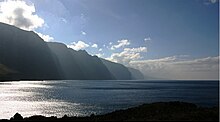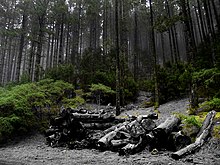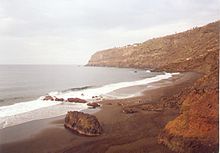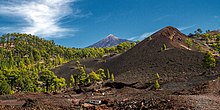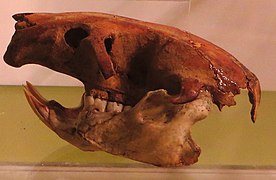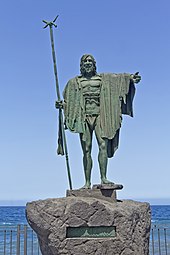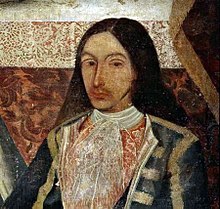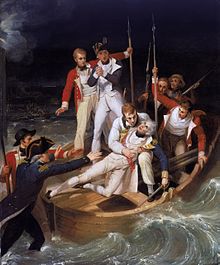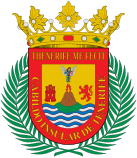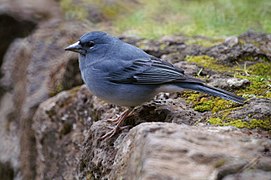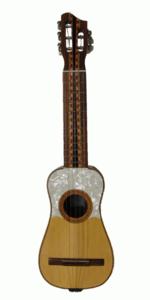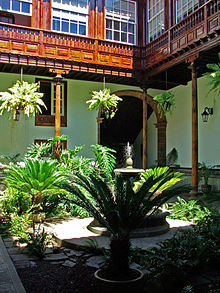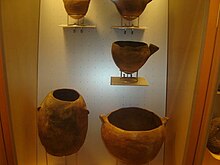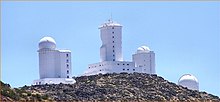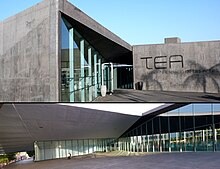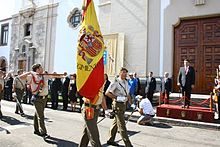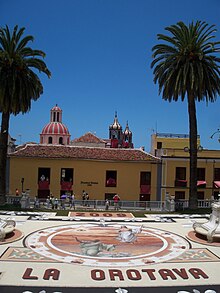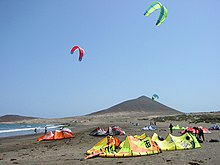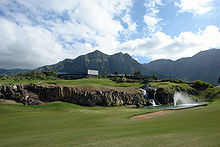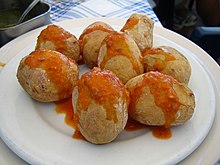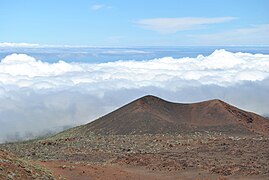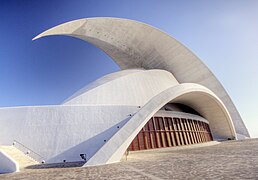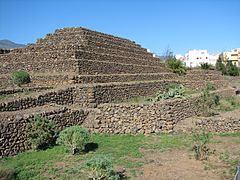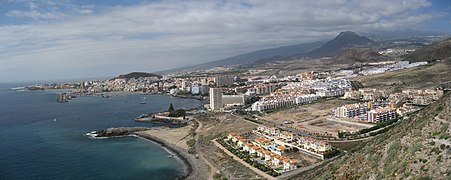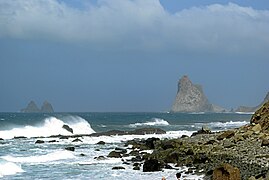Tenerife
Tenerife is an island in the Atlantic Ocean belonging to the Spanish autonomous community of the Canary Islands. Together with La Palma, La Gomera and El Hierro it makes up the province of Santa Cruz de Tenerife. With an area of 2,034.38 km² and a population of 931,646 inhabitants (2022), it is the largest island in the Canary archipelago and the most populous in Spain. In addition, Tenerife is also the largest and most populous island in the Macaronesia region.
The city of Santa Cruz de Tenerife is the capital of the island and of the province of the same name, as well as its most populous municipality, with 209,194 inhabitants (INE 2020). The city is also the capital of the autonomous community of the Canary Islands, sharing that status with Las Palmas de Gran Canaria. Despite this, between 1833 and 1927 Santa Cruz de Tenerife was officially the only capital of the Canary archipelago, until in 1927 a decree ordered that the capital of the Canary Islands be shared, which is how it remains today. The second largest municipality of inhabitants on the island, and third in the Canary Islands, with 155,549 inhabitants (INE 2018), is San Cristóbal de La Laguna, whose historic center is a World Heritage Site. The metropolitan area of Santa Cruz de Tenerife has a population of more than of 400,000 inhabitants.
The island has another place listed by UNESCO as a World Heritage Site, the Teide National Park, which is the most visited in Spain and one of the most visited in the world. of Spain and the third largest volcano in the world from its base on the ocean floor, Teide. For its part, the Anaga Massif, due to its natural and ethnographic wealth, was classified as a Biosphere Reserve, also by UNESCO, on June 9, 2015. It is the natural area with the largest number of endemic species in Europe.
Of great importance is the Carnival of Santa Cruz de Tenerife, declared a Festival of International Tourist Interest and considered one of the most important worldwide. In addition, the island has a variety of architecture, including the colonial and the contemporary, whose maximum exponent is the modern building of the Auditorio de Tenerife, located in Santa Cruz de Tenerife. The island is also known for being a great tourist destination, since it receives more than six million tourists each year, being, therefore, the main tourist destination in the Canary Islands, as well as one of the most important in Spain and the world.
Toponymy
There are various names that different cultures have attributed to Tenerife throughout history. Thus, for example, for the native Guanches the island received the name of Achinech, although depending on the bibliography that is consulted, the list can acquire different spelling variations such as Achineche, Chinechi or Chinet. According to the philologist Ignacio Reyes, the primitive form would be (w)a-zenzen with the value of 'resonance, buzz, rumble', while for professor Juan Álvarez Delgado Achinech −at-ti-ney− would be "an affectionate or affectionate expression" that translates as 'here is mine' or 'la mía', 'my land'.
Roman descriptions of the Fortunate Islands, such as that of Pliny the Elder in his work Naturalis Historia, included an island called Nivaria or Ninguaria (from the Latin nix, nivis, 'snow'), which is believed to refer to the snow that usually covers the Teide volcano.
Portolan maps of the XIV and XV usually designate the island as Insula del'inferno, 'island of Hell', probably due to the eruptive processes of which the volcano was the protagonist.
According to the first historians of the island such as Fray Alonso de Espinosa or Leonardo Torriani, the term Tenerife was adopted by the Castilians from the name used by the aborigines of La Palma to refer to it. This would come from the terms tener, 'snow,' and fe, 'mountain,' being translated as 'mountain. of snow' or 'snowy mountain' referring to the peak of Teide. The oldest known written mention of the term Tenerife is in the form Tenerefiz and dates from around 1350, in a literary work entitled Book of the Knowledge. However, throughout history other explanations have been given to reveal the origin of the island's name. For example, the 17th century historians Juan Núñez de la Peña and Tomás Arias Marín de Cubas, among others, supposed that it could come from the legendary Guanche king of Tinerfe nicknamed the Great, who ruled the entire island in times prior to the conquest by Castile.
Physical description
Tenerife is an island that is largely very abrupt, with relief formed by successive volcanic eruptions throughout history, the most recent of which was Chinyero in 1909.
Situation and extent
The island is located between parallels 28º and 29º N and meridians 16º and 17º W, slightly north of the Tropic of Cancer, occupying a central position between Gran Canaria, La Gomera and La Palma. It is located just over 300 km from the African continent, and about 1,000 km from the Iberian Peninsula.
Triangular in shape, Tenerife is the largest island in the Canary archipelago, with an area of 2034.38 km² and the longest coastline with 342 kilometers. In addition, it is the highest island in Spain and the tenth highest island in the world: in its center rises the peak of Teide, which with its 3718 m above sea level represents, in turn, the highest point in all of Spain, of the islands in the Atlantic Ocean and the third The world's largest volcano from its base on the ocean floor, second only to Mauna Kea and Mauna Loa (both in the Hawaiian archipelago). It has up to two hundred small islets or rocks around it, among which those of Anaga, Garachico, Fasnia stand out, which add up to a total of 213,835 m² more. Tenerife is also the largest and most populated island in the Macaronesia region.
Origin and formation
Tenerife is an island of volcanic origin, whose formation began to take shape on the ocean floor some 20-50 million years ago.
According to one of the theories most currently accepted by the scientific community (Theory of uplifted blocks), the rise of magma from the Earth's mantle occurs in periods of tectonic activity from faults or fractures that exist on the ocean floor. These follow the structural axes of the island, and were formed during the Alpine orogeny of the Tertiary Era by the movement of the African plate. These submarine fissure-type eruptions originate the so-called pillow lavas or pillow-lavas, which are produced by the rapid cooling experienced by the magma upon contact with the water, thus obtaining a very characteristic shape. These materials were accumulated and built the insular building under the sea. As it approached the surface, the gases, due to the decrease in the surrounding pressure, were released from the magma and the vulcanological episodes went from being calm to having a markedly explosive character, forming fragmentary materials.
After a long time of accumulation of materials, the birth of the island occurred at the end of the Miocene (Tertiary Era). Seven million years ago the areas of Teno, Anaga and Macizo de Adeje emerged, in what is called the Ancient Basaltic Series or Series I. In this way, three chronologically and stratigraphically different islands were formed at the western, eastern and southern ends of present-day Tenerife.
About 3 m BCE. a second volcanic cycle begins (Postmiocene Formations or Recent Series II, III and IV), much more intense, which incorporates elements in the central zone of the island, which also emerges and unifies the three previously described buildings into one. The structure formed at that time is called the Pre-Cañadas Building, on whose remains the Cañadas I Building would later be erected. The latter experienced various collapses and emitted a wide variety of explosive materials that gave rise to the so-called Southern Bands (present-day south-southeast).
Later, on the ruins of this complex, the Edificio Cañadas II would rise, already above 2500 meters, also with intense explosive processes. About 1 m ago. The construction of the Cordillera Dorsal began, with a fissure-type volcanism, from the remains of the already partially dismantled buildings of the Series I. The Cordillera Dorsal is the one with the greatest altitudinal and longitudinal development in the Canary Islands, with a height of 1,600 meters and a length of 25 kilometers. In this same chronological space (800,000 years ago) two gravitational landslides took place that motivated the appearance of the valleys of La Orotava and Güímar.
Finally, in more recent times (200,000 years), the eruptions began that would raise the Edificio Pico Viejo-Teide in the center of the island, on the Caldera de Las Cañadas .
Orography and landscape
The island's abrupt orography and its variety of climates result in a territory of multiple landscapes and forms, from the Teide National Park with its amalgamation of colors resulting from successive volcanic eruptions, to the cliffs of Los Gigantes with its walls vertical, passing through semi-desert areas with plants resistant to drought in the south, or through environments of a purely volcanic nature such as the Malpaís de Güímar or the Malpaís de La Rasca.
It also has natural beaches such as El Médano (with protected areas in its surroundings such as Montaña Roja and Montaña Pelada), valleys with tropical and subtropical crops, wooded laurel forests in the Anaga and Teno massifs (with deep and steep ravines) and extensive pine forests above this last plant formation.
Central building
The main structures of Tenerife, which are described below, make up the central building, with the Teide-Pico Viejo complex and the Las Cañadas circus. It is a semi-caldera measuring 130 square kilometers, which has been caused by a set of geological processes explained in the heading Origin and formation. The circus is partially occupied by the Teide-Pico Viejo stratovolcano and completed by the materials it has emitted in its different eruptions. The Roques de García stand out inside, among which is the best known, the Roque Cinchado. Another striking formation is Los Azulejos, made up of greenish-colored phonolites that have been created by hydrothermal activity.
To the south of La Caldera stands out the Guajara mountain, which at 2718 meters is the highest of those that make up the Las Cañadas del Teide amphitheater. At the foot of these walls, endorheic plains of very fine sedimentary materials have been created, the best known being the Llano de Ucanca.
The Teide peak, with 3,718 meters above sea level and more than 7,000 meters above the ocean floor, is the highest point on the island, on Spanish territory, and on all the emerged lands of the Atlantic. This volcano, the third largest on the planet from its base, is the symbol of Tenerife par excellence and the most emblematic natural monument of the Canary Islands. Its central location, its significant dimensions, its silhouette and its snowy landscape give it a unique unique personality. The Guanche aborigines already considered it a place of worship and worship.
Since 1954, Teide and the entire circus around it (although there was a later extension of its limits) has been declared a national park. In addition, since June 2007 it has been included by Unesco as a World Heritage Site as a natural asset. To the west is the Pico Viejo volcano. On one side of this, is the Chahorra Volcano or Narices del Teide, where the last eruption occurred in the Teide environment, in 1798.
Solid
The Anaga massif, in the northeastern end of the island, has an irregular and rugged topographic profile where, despite not presenting high elevations, the Cruz de Taborno stands out with 1024 meters. Due to the age of its materials (5.7 m a.), its deep erosion processes and the dense network of dikes that cross the massif, there are numerous rocks that appear on the surface, both of phonolitic and trachytic etiology. There is a large number of steep ravines and very embedded in the terrain. On the Anaga coast, cliffs predominate, so there are a few beaches; however, those that do exist tend to coincide with areas at the mouth of ravines, some rocky and others black sand.
The Teno massif is located in the extreme northwest. As in Anaga, it is an area of dismantled structures and deep ravines that have been created by erosion. However, here the materials are older (approximately 7.4 m. a.). They emphasize the mountain of Gala that with 1342 meters represents the highest altitude. The most unique landscape of this massif is found on its southern coast. These are the Los Gigantes cliffs, with vertical walls that can reach 500 meters in height at some points.
The Adeje massif is located at the southern end of the island, with the greatest exponent being Roque del Conde, at an altitude of 1,001 metres. The massif is not so appreciable due to its small initial structure, a fact that added to the geological history of the place has promoted an intense dismantling of its materials, thus losing its original appearance and size.
Bibs
The Dorsal Cordillera or Pedro Gil dorsal ranges from the beginning of Mount La Esperanza, at approximately 750 meters above sea level, to the central area of the island, in the vicinity of the Caldera de Las Cañadas, being Izaña, its highest point, with 2350 meters above sea level. This structure has been formed at the expense of a basaltic fissure volcanism through one of the axes or structural guidelines that have given rise to volcanism on the island.
The Abeque ridge is formed by a chain of volcanoes that join the Teno massif with the Teide-Pico Viejo central building from another of the three axes or structural guidelines of Tenerife. The historic Chinyero volcano belongs to this ridge, whose last eruption was recorded in 1909.
The South Ridge or Adeje Ridge is protected by the last of the structural axes. The remains of its massif stand out as an original formation, as well as the alignments of small volcanic cones and rocks scattered throughout this area of southern Tenerife.
The Anaga Ridge naturally divides the Anaga massif region from east to west. It separates the valleys of San Andrés (to the south) and Taganana (to the north).
Valleys
Valleys are another prominent landform. The most important are the valley of La Orotava and the valley of Güímar, which have been generated by the mass sliding of large amounts of materials towards the sea, creating a hollow in the terrain. There are other valleys that are distributed throughout various enclaves of the geography of Tenerife, although, in this case, of a different nature. They are usually interhill valleys that have been formed after the deposit of a greater amount of geological materials on lateral hills, or simply wide channels of certain ravines that in their evolution have taken on the appearance of typical valleys.
Ravines
Tenerife, mainly due to its high altitude and its silhouette resembling a gabled roof, is furrowed by a large number of ravines. These constitute one of the most characteristic elements of its landscape, originated by the erosion exerted by surface runoff throughout history. The Ruiz, Fasnia and Güímar ravines, the Infierno and Erques ravines stand out, all of them declared natural areas protected by the Canarian institutions.
Coasts
The coasts are generally rugged and abrupt, although they are more so in the north than in the south. However, 67.14 kilometers of the Tenerife coast are represented by beaches, only surpassed in this aspect by the island of Fuerteventura. On the northern coast, pebble or black sand beaches are frequent, while on the south and southwest slopes beaches with finer sand and lighter shades predominate on the island.
Volcanic Tubes
Lava tubes, or volcanic tubes, are volcanic caves, usually in the shape of tunnels, formed inside more or less fluid lava flows during reogenetic activity. Among the many existing volcanic tubes on the island, the so-called Cueva del Viento stands out, located in the northern municipality of Icod de los Vinos, which is the largest volcanic tube in Europe and one of the largest in the world, although for a long time it was considered even the largest in the world.
Flora and fauna
The island of Tenerife enjoys a remarkable ecological diversity despite its small surface area, which is a consequence of special environmental conditions, since the prevailing rugged orography locally modifies the general climatic conditions, originating a great variety of microclimates. This vast existence of microclimates and, therefore, of natural habitats, is manifested in the insular vegetation, made up of a rich and varied flora (1400 species of higher plants), among which there are numerous endemic Canary Islands (200) and exclusively from Tenerife (140).
By concentrating this plant heritage of some 140 exclusive species, the island of Tenerife shows the largest list of floristic endemisms of the so-called Macaronesia. In addition, the different chemical composition of the various volcanic materials that have built the island building, always under the combined action of climatic factors, it gives rise to a great diversity of soils. The conjunction of these agents determines the presence of multiple habitats that house numerous communities of plants and animals that constitute the unique ecosystems of Tenerife.
The study of the flora and fauna of Tenerife can be carried out in a more orderly way if it is classified according to the different ecological floors into which the land of the island is divided. This division pays special attention to the north or south orientation of the slopes of the island and, of course, to the altitude:
- Cardonal-tabaibal: 0-700 m: This stratum is characterized by a strong insolation and a shortage of precipitation. In it stands out as plant species the tabaibas, cardones and cardoncillos, bejeques,...In terms of the fauna, the animal species vertebrate in this ecosystem are poor; if at all, some birds or reptiles. Instead, insects are very well represented.
- Thermophile forests: 200-600 m: This floor has a higher degree of humidity and precipitation, and a lower insolation. The palm trees, the sainas, the acebuches and a series of endemisms are important within the arboreal species, such as pearls, guaidiles, scarves, risco malvas and filmmakers. In relation to the fauna it is necessary to cite the vanessa vulcania butterfly and insectivorous birds such as the Cabecinegra curl and the capirote.
- Laurisilva: 500-1000 m: It is a dense forest of large trees, heirs of the flora of the Terciaria Era, which grow in areas of abundant fog and frequent rains. The superior plant species that abound are laurels, tiles, viñátigos, barbusanos, and other smaller species such as bicacaro, cock crest, stork and a wide variety of ferns. With respect to fauna, laurisilva is the richest stratum invertebrates and with the highest percentage of endemisms, among which are worms, molluscs and above all arthropods. Within the vertebrate fauna we must mention some species of bats and two endemic birds in danger of extinction such as turquoise pigeons and rabiche.
- Fayal-brezal: 1000-1500 m: It is also a forest, but in this case it is more dry and poor in species. Floristically highlight the fayas, brezos, acebiños,... There are also many different species of mushrooms that can be both edible and very poisonous.
- Paint: 800-2000 m: Open-ended pine forest characterized by increased insolation and lower uniformity in day-to-day and seasonal temperatures. It stands above any other species the canary pine. The fauna is rare, but there are two endemic birds of singular beauty such as the blue pine and the picapino peak.
- High mountain: Over 2000 m: it has a dry climate, a very high insolation and extreme temperatures. Despite these demanding conditions, plant endemisms grow of great scientific importance and beauty such as red tajinastes, Teide retama, codesos, Teide violet and animal species mainly invertebrates such as beetles, chinches, and butterflies.
We still need to talk about the extensive marine fauna among which stand out old, grouper, abbots, salemas, samas, snappers, etc. The loggerhead turtle and the permanent colonies of whales and dolphins that inhabit the south coast of the island are also of great interest. Tenerife has a faunal inventory that amounts to 56 species of birds, 13 land mammals, 5 reptiles, several thousand invertebrates, 2 amphibians and 400 fish, as well as some species of sea turtles and cetaceans.
Prehistoric fauna
Before the arrival of the aborigines, the Canary Islands, and especially Tenerife, were inhabited by prehistoric endemic animals, most of which are now extinct. These specimens reached larger sizes than usual, this is what is called island gigantism.
Among these species, the best known found in Tenerife were;
- The giant lizard (Gallotia goliath): Inhabited the island of Tenerife from the Holocene to the centuryXV of our age. It was a specimen that reached a length of 120 to 125 centimeters.
- The giant rat (Canariomys bravoi): Its fossils mostly date from the Pliocene and Pleistocene. Its skull reached up to 7 centimeters in length, so it could have reached the size of a rabbit, making it the largest of its family and considerably large compared to other European rat species. The fossils of Canariomys bravoi usually appear in tubes and volcanic caves associated with Gallotia goliath.
- The giant turtle (Centrochelys burchardi): It was a large land turtle, similar to those currently in some oceanic islands such as the Galapagos Islands in the Pacific Ocean and the Seychelles Islands in the Indian Ocean. The remains found date from the Miocene. It is believed that the island lived to the upper Pleistocene and that its extinction was due to volcanic events long before the arrival of the human being. Its shell was about 65 to 94 cm.
Protected natural areas
Practically half of the island (48.6%), is under the different protection formulas attributed by the Canary Islands Network of Protected Natural Areas. Of the 146 natural spaces collected by the aforementioned network in the archipelago as a whole, a total of 43 are found in Tenerife, thus being the island that has the largest number of spaces. Likewise, considering the percentage of territory protected with the Since each island contributes to the total for the archipelago, it should be noted that Tenerife is the island that leads the table with 37%. The Network contemplates up to eight different protection categories, all of them represented on the island: apart from the Teide National Park, has the largest natural park in the Canary Islands (Corona Forestal), two rural parks (Anaga and Teno), four comprehensive nature reserves, six special nature reserves, a total of fourteen natural monuments, nine protected landscapes and up to six sites of scientific interest.. On June 9, 2015, the Anaga massif was declared a biosphere reserve by Unesco. The Anaga massif is the place with the greatest number of endemic species in Europe.
The municipality of La Orotava, largely at the expense of the Teide National Park, and that of Santa Cruz de Tenerife, which does the same with the Anaga Rural Park, present, respectively, 76% and 74% of their extension under protection. In the same way, the majority location of the Teno rural park under the protection of the municipality of Buenavista del Norte means that it has an important part of its protected area.
The complete list of the protected areas of Tenerife is as follows:
National Parks
- Teide National Park
Comprehensive nature reserves
- Integral Natural Reserve of Pijaral
- Integral natural reserve of Ijuana
- Integral natural reserve of Pinoleris
- Integral natural reserve of the Roques de Anaga
Special Nature Reserves
- Special natural reserve of the Barranco del Infierno
- Special natural reserve of Chinyero
- Special natural reserve of Malpaís de Güímar
- Special natural reserve of Malpaís de la Rasca
- Special Nature Reserve of Red Mountain
Natural parks
- Natural Park of the Forestry Crown
Rural parks
- Rural park of Anaga
- Teno Rural Park
Natural monuments
- Natural monument of the Barranco de Fasnia and Güímar
- Natural monument of the Caldera del Rey
- Natural monument of Los Derriscaderos
- Natural monument of Yellow Mountain
- Natural Monument of the Mountain Sentinel
- Natural Monument of The Colorful Mountain
- Natural monument of the Mountain of Guaza
- Natural Monument of The Mountain of the Friars
- Natural monument of the Tejina Mountain
- Natural Monument of the Pelada Mountain
- Natural monument of The Mountains of Ifara and Los Riscos
- Natural monument of the Roque de Garachico
- Natural monument of the Roque de Jama
- Natural monument of the Teide
Protected landscapes
- Protected Landscape of The Acantilados de la Culata
- Protected landscape of the Barranco de Erques
- Protected Landscape of Costa de Acentejo
- Protected Landscape of Ifonche
- Protected Landscape of the Resbala
- Protected Landscape of Las Lagunetas
- Protected Landscape of the Seven Lomas
- Protected landscape of Los Campeches, Tigaiga and Ruiz
- Protected landscape of the Rambla de Castro
Scientific sites of interest
- Site of scientific interest of La Hondura
- Site of scientific interest of Isorana Acantilados
- Site of scientific interest of Barranco de Ruiz
- Site of scientific interest of Interián
- Site of scientific interest of La Caleta
- Site of scientific interest of Tabaibal del Porís
Climate
Tenerife is known internationally as the "Island of Eternal Spring". The attribution of this climatic denomination occurs largely thanks to the trade winds, whose humidity mainly condenses on the midlands of the north and northeast of the island, constituting wide seas of clouds that are preferably between 600 and 1800 meters high.
Another factor that influences the smoothness of the climate of the Islands with respect to the one that would correspond by latitude (Sahara desert), is the cold marine current of the Canary Islands, which cools the temperature of the waters that bathe the coasts and island beaches with respect to the environment. Lastly, the orography of Tenerife itself should also be taken into account in this list of agents in charge of making the aforementioned slogan a reality.
Broadly speaking, the climate of Tenerife is moderate, temperate and very mild in any season of the year. There are no periods of cold but neither are there periods of suffocating heat. The average temperatures are 18 °C in winter and 25 °C in summer, although these are relative and general values. Obviously, there are important contrasts, such as the one that occurs during the winter months, in which it is possible to enjoy the sun in coastal areas and, nevertheless, 3000 meters above, to be able to contemplate the white snow-capped Mount Teide, a place where it snows every year.
Another example of climatic contrast would be found in the city of Santa Cruz with respect to the city of La Laguna. Municipalities physically united but distanced in terms of climatic conditions. Generally, Santa Cruz has a warm climate throughout the year with temperatures significantly higher than those enjoyed in the neighboring La Laguna, where it is often a little colder and there is a greater probability of precipitation, and whose climate is similar to the midlands of the north of the peninsula.
The north and south of Tenerife also have different climatic characteristics. In windward, 73% of the total rainfall is recorded, in addition, the relative humidity of the air is higher and the insolation is lower. The maximum rainfall is recorded on the windward side at an average altitude between 1,000-1,200 m, almost exclusively in the mountains of La Orotava.
But perhaps it is more significant that the entire north of the island lacks a space in which the average rainfall is less than 250 mm per year. On the other hand, on the southern slope of the island the rainfall values are significantly lower. The only southern strongholds that are spared from this situation are Masca and Güímar, probably due to their physical characteristics that allow a greater presence of the trade winds.
As an anecdote, it is interesting to know that European doctors, especially English and Dutch, from the past XIX praised the climate of the north of Tenerife, and they recommended it to their patients to alleviate ailments of age and the circulatory system.
| Climate data | January | February | March | April | May | June | July | August | September | October | November | December |
|---|---|---|---|---|---|---|---|---|---|---|---|---|
| Sun/day hours | 5.9 | 6.6 | 7.1 | 7.7 7.7 | 8.8 | 9.8 | 10.6 | 9.8 | 8.5 | 6.9 | 5.9 | 5.5 |
| Air (°C) | 17,9 | 17,9 | 18.6 | 19,0 | 20.4 | 22.2 | 24.3 | 25,0 | 24.3 | 22.8 | 20.6 | 18.7 |
| Water (°C) | 19 | 18 | 18 | 18 | 19 | 20 | 21 | 22 | 23 | 23 | 21 | 20 |
| Days of rain/month | 5 | 5 | 5 | 3 | 1 | 0 | 0 | 1 | 1 | 3 | 5 | 6 |
Water
The volcanic soil of Tenerife, generally of a porous and permeable nature, is the reason why a considerable fraction of the water coming from the rain, together with that product of condensation in wooded areas and that coming from the melting of the highest peaks of the island, infiltrates underground.
The construction of reservoirs and dams as the main methods of obtaining water is discouraged due to the aforementioned geological conditions, which do not allow the storage of the precious liquid on the surface, as well as the irregularity of rainfall.
In this way, most of the water (90%) comes from wells and mainly from galleries, important systems that serve to extract water resources from the aquifer. Tenerife currently has more than a thousand drilled galleries.
Floors
The complex formation and geological evolution of Tenerife, in conjunction with the different orographic and bioclimatic characteristics, offer as a result a wide range of soils, mainly attending to their greater or lesser degree of evolution. In this sense, the soils of the areas exposed to the south behave as less developed; however, the areas to the north, affected by the trade winds, which provide great humidity, show higher levels of evolution. When delving into this chapter, it is important to establish a classification of them based on their capacity for agricultural use or not, as well as their limitations and the risks involved.
- High-use capacity floors: These lands are suitable for almost any activity, including moderately intensive agricultural exploitation. This is especially about land transported from other parts of the island. Its main disadvantage is that, from the point of view, on many occasions on these lands, recent volcanic materials are superimposed through new eruptions. They are usually plain areas, but formed by too recent elements, in which erosion has not yet been able to generate soil on the rock. Because of this, land is brought from less suitable places for cultivation, where the soil is suitable for this use.
- Medium-purpose capacity floors: They are soils capable of resisting unintensive uses as they pose a high risk of erosion. They are available on more recent volcanic materials.
- Grounds with low capacity for use: These lands are characterized by being placed in high slope areas. They are not, thus, the most convenient to grow. It also entails significant risks, potential uses involving earth movements.
- Soils with very low capacity of use: As they are located on recent lines, these grounds are not advisable almost for any activity.
History
The pre-Hispanic population: the Guanches
The Guanches must have arrived in Tenerife in a period from before the V century a. C. until the beginning of the Christian Era. For almost 2,000 years, they inhabited the island and tried to adapt to its environmental characteristics until in 1496 they were subdued by Spanish troops.
The archaeological zone of the Cueva de los Guanches in the municipality of Icod de los Vinos, has provided the oldest chronologies of the Canary Islands, dating from around the century VI a. C.
Regarding the technological level, the Guanches can be classified among the peoples of the Stone Age, although this terminology is rejected due to the ambiguity it presents. The Guanche culture is characterized by an advanced cultural development, which is possibly related to the Berber cultural traits imported from North Africa and a poor technological development, determined by the scarcity of raw materials, especially minerals that allow the extraction of metals. Their main activity was grazing, but they also engaged in agriculture, gathering, fishing, shellfishing or handicrafts.
In terms of beliefs, the Guanche religion was polytheistic although the astral cult was widespread. Along with him there was an animist religiosity that made certain places sacred, mainly rocks and mountains. Among the main Guanche gods could be highlighted; Achamán (god of heaven and supreme creator), Chaxiraxi (mother goddess later identified with the Virgin of Candelaria), Magec (god of the sun) and Guayota (the devil) among many other gods and ancestral spirits. Especially singular was the cult of the dead, practicing the mummification of corpses. In addition, small anthropomorphic and zoomorphic lithic and clay figurines have appeared on the island associated with rituals, interpreted as idols. Among these stands out the so-called Idol of Guatimac, which is believed to represent a genius or protective spirit.
Guanche society was divided into strata defined by wealth, especially heads of cattle, differentiated on one side by the nobility and on the other by the people. The island was divided into territories whose king was the mencey (name given to the Guanche monarch of Tenerife, who ruled a menceyato or territory). About a hundred years before the conquest, there was a mencey named Tinerfe el Grande, son of the mencey Sunta. Tinerfe had his court in Adeje from where he ruled the entire island. Upon his death, his nine sons rebelled and divided the island into nine independent menceyatos and two achimenceyatos (called captaincies by the conquerors). The menceyatos and their menceyes (in order of descent) were the following:
- Taoro: Currently Puerto de la Cruz, La Orotava, La Victoria de Acentejo, La Matanza de Acentejo, Los Realejos y Santa Úrsula sus menceyes fueron Bentinerfe, Inmobach, Bencomo y Bentor.
- Güímar: Today El Rosario, Candelaria, Arafo and Güímar and their menceyes were Acaymo, Añaterve and Guetón.
- Abona: Fasnia, Arico, Granadilla de Abona, San Miguel de Abona, Arona and his menceyes were Atguaxoña and Adxoña (or Adjoña).
- Anaga: Santa Cruz de Tenerife and San Cristóbal de La Laguna (the area of the lagoon itself) and its menceyes were Beneharo and Beneharo II.
- Tegueste: Tegueste, part of the coastal zone of La Laguna and the lagunera vega itself, its menceyes were Tegueste I, Tegueste II and Teguaco.
- Tacoronte: Tacoronte and El Sauzal and his menceyes were Romen and Acaimo.
- Icode: San Juan de la Rambla, La Guancha, Garachico and Icod de los Vinos and his menceyes were Chincanayro and Pelicar.
- Daute: The Tank, Los Silos, Buenavista and Santiago del Teide and their menceyes were Cocanaymo and Romen.
- Adeje: Guide to Isora, Adeje and Vilaflor and their menceyes were Atbitocazpe, Pelinor, and Ichasagua.
There was also the Achimenceyato of Punta del Hidalgo governed by Aguahuco (the "Poor Hidalgo", illegitimate son of the Great Tinerfe) and Zebenzui.
Despite the time elapsed since the conquest of the archipelago, many place names still remain today that remind us of the language of the Guanches. There are many places that, although with important variations, retain their pre-Hispanic name.
Archaeological sites of interest
The island also has several archaeological sites from this pre-conquest era. In general, this heritage is represented by rock caves that, although they are distributed throughout the insular geography, the majority are found on the southern slope.
Two of the most important archaeological sites on the island are: the archaeological zone of the Cueva de los Guanches, where the oldest settlements in Tenerife have been found and have provided the oldest chronologies of the archipelago, with dates around to the VI century a. C. and the so-called Cuevas de Don Gaspar, due to the discovery of plant remains in the form of carbonized seeds, which confirms the practice of agriculture on the island of Tenerife in Guanche times. Both sites are located in the municipality of Icod de los Vinos. Also noteworthy on the island is the Masca solar station, which was an aboriginal sanctuary for the celebration of rites related to fertility and the request for rainwater. This is located in the municipality of Buenavista del Norte.
Other important sites to highlight are the Los Cambados Archaeological Zone and the El Barranco del Rey Archaeological Zone, both in the municipality of Arona. We could also highlight the Cueva de Achbinico (the first Marian sanctuary in the Canary Islands, from the Guanche-Castilian period) and this place where various archaeological utensils from the Guanche period long before the conquest have appeared. Another place of great archaeological interest is the Macizo de Anaga, this area of the island is one of the richest places in archaeological finds in the Canary Islands. A large number of Guanche mummies have been found in this place as well as caves with some mummified animal remains, and stones with inscriptions such as the so-called "Piedra de Anaga". On the other side of the island in the municipality of El Tanque another stone was found with inscriptions the "Piedra Zanata" which seems to have been related to the magical-religious world of the Guanches. Also on the island are the controversial Pyramids of Güímar, of which there are many hypotheses about their construction, although an official definition of their origin has not yet been given.
There are also vestiges in Tenerife that reveal the Punic presence on the island, such as the stela commonly called "Piedra de los Guanches" in the town of Taganana. This archaeological site is made up of a structure formed by a large stone block, in the open air, which presents rock carvings on its surface. Among these, the presence of a representation of the Carthaginian goddess Tanit stands out, represented by a symbol in the shape of a bottle surrounded by cruciform motifs. It is thought that the monument was originally a sacrificial altar linked to those found in the Semitic sphere and later reused for the aboriginal ritual of mummification.
Conquest
Tenerife was the last island in the Canary Islands to be conquered and the one that took the longest to submit to the Castilian troops. Although the traditional dates for the conquest of Tenerife are established between 1494 (landing of Alonso Fernández de Lugo) and 1496 (conquest of the island), it must be borne in mind that attempts to annex the island of Tenerife to the Crown of Castile date back at least to 1464. From the first attempt to conquer the island in 1464, until it was definitively conquered in 1496, thirty-two years elapsed.
In that year of 1464, the symbolic takeover of the island by the Lord of the Canary Islands, Diego García de Herrera, took place in the Bufadero ravine. He signs a peace treaty with the menceys, allowing the Anaga mencey to build a tower on his land, where the Guanches and Europeans have deals until it is demolished around 1472 by the same Guanches.
In 1492 the governor of Gran Canaria Francisco Maldonado organized a raid that ended in disaster for the Europeans, as they were defeated by the Guanches from Anaga.
In December 1493, Alonso Fernández de Lugo obtained from the Catholic Monarchs the confirmation of his rights of conquest over the island of Tenerife. In April 1494, and coming from Gran Canaria, the conquistador landed on the coast of what is now Santa Cruz de Tenerife with a troop of peninsulars and Canaries (from La Gomera and Gran Canaria, above all) made up of about 2,000 men on foot and 200 on foot. horse. After building a fort he set out to enter the interior of the island.
The menceyes of the island of Tenerife took different positions at the time of the conquest. Thus, the band of peace and the band of war were formed, the first made up of the menceyatos of Güímar, Abona and Adeje, and the second of Anaga, Tegueste, Tacoronte, Taoro, Icoden and Daute. The opposing side tenaciously confronted the Castilians so that the conquest of Tenerife lasted for two years. The Castilian troops suffered a defeat at the hands of the Guanches in the First Battle of Acentejo in 1494. However, the Guanches, outmatched by technology and by new diseases to which they were not immune, fell to the troops of the Crown. of Castile in the battle of Aguere and in the second battle of Acentejo culminating in the conquest in September 1496.
As in the rest of the islands, many of the aborigines were enslaved, especially those belonging to the bando de guerra, while a good part of the indigenous population succumbed to imported diseases such as the flu and, probably smallpox, infectious diseases for which that Neolithic society, due to its isolation, had not developed its immune system. After the conquest, and especially during the century after it, the island gradually repopulated and colonized with the arrival of immigrants from various territories belonging to the incipient Spanish Empire (Portugal, Flanders, Italy, Germany).
The forests of Tenerife were gradually affected by population growth and the consequent need to obtain cleared land that would allow agricultural exploitation for own consumption and for export. This was the case with the introduction of sugarcane cultivation at the beginning of the XVI century while, in succeeding centuries, The island's economy focused on the use of other crops such as the vine and cochineal to make dyes, as well as bananas.
American Commerce
During the XVIII century, after the War of the Spanish Succession, the so-called " Canary-American trade", which was regulated by a Royal Decree of 1697. This granted the Canary Islands trade with America for eight years and limited it to 1000 tons. 600 corresponded to Tenerife, 300 to La Palma and 100 to Gran Canaria.
Tenerife was in this sense the hegemonic island, since it exceeded 50% of the number of ships and 60% of the tonnage. On the islands of La Palma and Gran Canaria, the percentage was around 19% for the first and 7% for the second. The volume of traffic between the Indies and the Canary Islands is unknown, but it must have been very important and was concentrated almost exclusively in Tenerife.
Among the products that were exported, the following stood out: cochineal, rum, and sugar cane, which were landed mainly in the American ports of La Guaira, Havana, Campeche, and Veracruz. The importance of Tenerife was the decisive boost for the port of Santa Cruz de Tenerife, which became the only commercial port on the island, surpassing those of Garachico and Puerto de la Cruz in importance in Indian trade.
Many sailors from Tenerife joined this transcontinental maritime trade, among them the corsair Amaro Rodríguez Felipe, more commonly known as Amaro Pargo. His participation in the race to the Indies began in the two-year period 1703-1705. He was captain of the frigate El Ave María y las Ánimas, a ship with which he sailed from the port of Santa Cruz de Tenerife to Havana. Other important Tenerife sailors of the time also include: Juan Pedro Dujardín and Bernardo de Espinosa, both companions of Amaro Pargo.
With the general application of free trade in 1778 and the War of Independence of the United States, it meant the total stoppage of traffic, until the peace of 1783. From then on, this commercial route began to decline. Late 18th century and early XIX, the Canarian-American trade came to an end due to a stage of great warfare between countries that paralyzed trade for several years.
The Attack of Horatio Nelson
Tenerife was attacked, like the other islands, by corsairs of various nationalities (French, English, Dutch and Barbary) several times throughout its history, depending on the evolution of alliances and wars in Spain. Among these attacks, the attack by the British in 1797 stands out for its place in history.
On July 25, Admiral Horatio Nelson attacked Santa Cruz de Tenerife, capital of the island and Headquarters of the General Captaincy. After a fierce attack, the defense organized by General Gutiérrez repelled the British. Nelson lost his right arm to a cannonball (legend says Tiger cannon) while trying to land on the shoreline of the Paso Alto area.
On September 5, another landing attempt in the Puerto Santiago region was repelled by the inhabitants of the Santiago del Teide Valley, who hurled stones at the British from the top of the Los Gigantes cliffs.
Other corsairs, mainly English, also attacked the island of Tenerife with varying degrees of success, Robert Blake (1656), Walter Raleigh, John Hawkins, John Genings (1706), Woodes Rogers, among others.
Emigration to America
Tenerife, in the same way as other islands, has kept a close relationship with America. Since the beginning of the colonization process of the New World, there were several expeditions that before crossing the Atlantic made a stopover on the island and added to the passage numerous Tenerife residents who formed an integral part of the conquest expeditions or who simply left in search of better guarantees. of future heading to the American continent. In turn, regardless of human transit, the exchange of animal and plant species that was established between the two lands was important.
After a century and a half of relative growth around the year 1670, the complicated foreign trade of the wine sector led to the emigration of many families, especially to Venezuela and Cuba. In addition, around those dates, interest arose on the part of the Crown to populate those empty areas of America in order to avoid their occupation by other powers, as had happened in the case of the English with Jamaica or the French with the Guianas or the west of Hispaniola, so that important consignments of Canary Islanders, including Tenerife, left for the new Colombian destination. The growing cocoa agriculture in Venezuela and tobacco farming in Cuba, at the end of the XVII century and beginning of the XVIII, contributed to the almost complete depopulation of towns such as Buenavista del Norte, Vilaflor or El Sauzal. Testimony of the island's emigrant history was the foundation on the outskirts of Santo Domingo of the town of San Carlos de Tenerife in 1684. This town, founded essentially by Tenerife residents, was created with a clear strategic objective as it allowed the city to be preserved from the siege of the French established in the western part of the island of Hispaniola. Between 1720 and 1730, 176 Canarian families were transferred by the Crown, including many from Tenerife, to the Caribbean island of Puerto Rico. In 1726, around 25 island families emigrated to America to end up founding the city of Montevideo. Four years later, in 1730, another group left that, the following year, founded the city of San Antonio, Texas, in the United States. Then, between 1777 and 1783, the port of Santa Cruz de Tenerife said goodbye to the founders of San Bernardo, in the state of Louisiana, and also to some shipments bound for Florida.
Due to the economic problems derived from the scarcity of raw materials and the distance from Europe, emigration to the American continent, mainly to Cuba and Venezuela, continued for centuries XIX and early XX. For decades, with the new policies to protect the Canarian economy and with the rise of the tourist industry, the migratory dynamic has been reversed, and today it is Tenerife that attends to the return of these islanders, their descendants and other immigrants, thus enduring the influence that germinated five centuries ago.
Historical Volcanic Eruptions
The volcanic eruptions that have occurred in Tenerife of which there is undoubtedly historical evidence are limited to five. The first of these was in 1492 at the Boca Cangrejo volcano, which was observed by Christopher Columbus. The next one occurred in 1704, when the volcanoes of Arafo, Fasnia and Siete Fuentes erupted synchronously. Two years later, in 1706, the largest eruption in history took place when the Trevejo volcano erupted. This spewed large amounts of lava that buried the city and port of Garachico, at that time the most important on the island. The last volcanic eruption of the XVIII century occurred in 1798 in the Cañadas de Teide, specifically in Chahorra. Finally, in 1909, eruptive activity erupted in the Chinyero volcano, in the municipality of Santiago del Teide. Subsequent to that date and up to the present time there have been no new eruptions on the island. In addition, despite the completely volcanic nature of Tenerife, the five historical eruptive episodes have not caused any fatalities.
Recent history
Other, less hostile visitors would come to the island in succeeding centuries. In 1799 the naturalist Alexander von Humboldt ascended the peak of Teide and commented on the beauty of the island.
Numerous tourists began to visit Tenerife from the 1890s, especially the northern cities of Puerto de la Cruz (the first tourist municipality in the Canary Islands through a ministerial order of October 13, 1955 that declared it a 'Place of Tourist Interest') and Santa Cruz de Tenerife.
In March 1936, General Francisco Franco was assigned to Tenerife by the Republican government, fearful of his military and political influence, in order to distance him from the centers of power.
The collision between two planes that occurred on March 27, 1977 at the Tenerife Norte airport, in the north of the island, continues to be the accident with the highest number of deaths in the history of aviation. The planes involved in the tragedy were destined for Gran Canaria, but had been diverted to Tenerife due to the explosion of a bomb (planted by the separatist terrorist group MPAIAC) at the Gran Canaria airport.
At the start of the XXI century, the Tenerife flood of 2002 took place on March 31 of that year. It was a cold drop phenomenon characterized by the repeated fall of torrential rains accompanied by electrical equipment, affecting the metropolitan area of Santa Cruz de Tenerife and extending in a NE direction towards the San Andrés area. The rains caused 8 deaths, 12 missing and dozens injured. In addition to the human losses, the flood caused extensive material damage, 70,000 people without electricity, as well as the total or partial destruction of at least 400 homes. Losses were estimated at 90 million euros.
On the other hand, in November 2005, Tenerife was the Canary Island most affected by tropical storm Delta. Winds of 140 km/h were recorded on the coast and almost 250 km/h on Mount Teide, the summit of Tenerife.
Gentilic
The formal name is "tinerfeño/a", although the name "chicharrero/a" is also used colloquially. However, the latter is typical of the inhabitants of the capital, Santa Cruz de Tenerife.
The name "chicharrero" It comes from a derogatory term used by the inhabitants of the nearby city of La Laguna, then the capital of the island, for the inhabitants of the then poor and small fishing port. Precisely because of this poverty, the inhabitants of Santa Cruz had to settle for eating mackerel, a small and cheap fish of relatively low quality; Where does the term come from? With time and the growth of Santa Cruz, until the transfer of the capital from La Laguna, under the reign of Fernando VII (XIX century ), its citizens took the insult to honor and assumed the name as their own.
Symbols of the island
The flag of Tenerife was originally adopted in 1845 as a distinctive or registration flag of what was then called the maritime province of the Canary Islands based in the Port of Santa Cruz de Tenerife. Currently, this ensign represents the entire island of Tenerife. It was approved at the request of the Island Council by Order of the Government of the Canary Islands on May 9, 1989 and published on May 22, 1989 in the Official Gazette of the Canary Islands.
The heraldic shield of Tenerife was granted by royal diploma on March 23, 1510, granted by King Ferdinand V "El Católico", it was issued in Madrid in the name of his daughter Juana, Queen of Castile. The shield is described in a field of gold, with Saint Michael the Archangel (patron saint of the island) armed overcoming a mountain of its natural color from which flames sprout, and which represents the peak of Teide. Under this mountain the island of sinople on blue and silver waves. On the right there is a castle gules, and on the left a rampant lion gules. The shield used by the Island Council differs from the one used by the La Laguna City Council in the motto that appears on the border and in the addition of some palm branches.
Natural symbols
According to a law of the Government of the Canary Islands, the natural symbols of the island since 1991 are the blue finch and the dragon tree.
Governing Body
The governing body of the island of Tenerife is the Cabildo Insular de Tenerife with headquarters in the Plaza de España in the capital of Tenerife (Palacio Insular de Tenerife). The political organization of the Canary Islands is characterized by the fact that it does not have a provincial political body, but rather each island has its own island council. In Tenerife, its current president is Pedro Manuel Martín Domínguez (PSOE). Since it was established in March 1913, it has had a wide range of its own powers, today included in the Statute of Autonomy of the Canary Islands and regulated by Law 14/1990, of July 26, on the Legal Regime of the Public Administrations of the Canary Islands.
The Cabildo is made up of the following bodies:
- Presidency
- Plenary
- Governing Council
- Informational Commissions
- Board of Spokespersons
Territorial division
The island of Tenerife is divided into 31 municipalities, making it the Canary Island with the most municipalities.
Of all of them, only three have no coast: Tegueste, El Tanque and Vilaflor. La Orotava is the municipality with the highest altitude in Spain as it is home to the Teide peak, while Vilaflor de Chasna has the highest municipal capital in all of the Canary Islands, being at an altitude of 1400 metres.
The largest municipality with 207.31 km² is La Orotava, which covers a large part of the Teide National Park. The smallest municipality on the island and the archipelago is Puerto de la Cruz, with an area of less than 9 km².
The vast majority of these municipalities come together in the central summit area of the island and from there they extend towards the coast, some oriented to the north and others to the south.
In turn, it is common to find another type of insular division, it is one that establishes the territory according to a Metropolitan Zone, around the area of influence of the cities of Santa Cruz and La Laguna (see Metropolitan Area of Tenerife), Zona Norte (those municipalities that open to the ocean to the north) and Zona Sur (those that do so to the south). This division together with the municipal one can be seen on the map on the right.
The list of all the Tenerife municipalities in alphabetical order is shown below:
| Adeje | Granadilla de Abona | Port of the Cross |
| Arafo | Isora Guide | San Cristobal de La Laguna |
| Arico | Güímar | San Juan de la Rambla |
| Arona | Icod de los Vinos | San Miguel de Abona |
| Buenavista del Norte | The Guancha | Santa Cruz de Tenerife |
| Candelaria | The Matanza de Acentejo | Holy Ursula |
| The Rosary | The Orotava | Santiago del Teide |
| The Sauzal | The Victory of Acentejo | Tacoronte |
| The Tank | The Realejos | Tegueste |
| Fasnia | The Silos | Vilaflor de Chasna |
| Garachico |
In addition, all these municipalities have traditionally been grouped into 8 regions. However, in 2011 the Island Council, through the Island Planning Plan of Tenerife, defined up to 11 regional models, whose basic lines largely coincide measured with those traditionally considered in the works that have been carried out on the island from different approaches. In this way, the island is divided into the following eleven regions:
- Abona
- Acentejo
- Anaga
- Metropolitan Area
- Icod-Daute-Isla Baja
- Central Massif
- Southeast
- Southwest
- Teno
- Güímar Valley
- Valle de La Orotava
Demographics
Tenerife is the most populated island in the Canary Islands and in Spain, as a result of the growth in the birth rate and the large foreign immigration that the island has received in the last decade (200,000 immigrants reside in Tenerife). The As of January 1, 2022, the island was home to a total of 931,646 registered inhabitants, according to INE sources.
| Graphic of demographic evolution of Tenerife between 1900 and 2021 |
 |
Official regular residents according to ISTAC population censuses. |
It is known that after the conquest of the Canary Islands, Tenerife quickly became the most populous island in the Canary archipelago, a distinction it maintained until well into the century XX. Since the Aranda Census of 1768, Tenerife and Gran Canaria have always been the two most populous islands in the archipelago, with Tenerife occupying first place until 1940. In the last half century, Gran Canaria has been the most populous of the Canary Islands, until 2002 when Tenerife surpasses it again.
Currently the other large Spanish islands that follow Tenerife in population are Mallorca with 880,113 inhabitants and Gran Canaria with 846,717 inhabitants in 2018. Around 25% of the total population of the island of Tenerife (222,643 inhabitants) are in its capital municipality, Santa Cruz de Tenerife, and about 45% (403,013 people) in its metropolitan area. Unlike other Canary Islands, Tenerife's population is widely dispersed throughout different cities and municipalities. The cities of Santa Cruz de Tenerife and San Cristóbal de La Laguna are urbanistically linked through the population centers of La Cuesta and Taco, housing together more than 359,000 inhabitants, making up the Metropolitan Area of Santa Cruz de Tenerife, the second most populated in the Canary Islands after that of Las Palmas de Gran Canaria, being that of Santa Cruz de Tenerife also, the fourteenth in population in the country.
Tenerife has two other metropolitan areas recognized by the Ministry of Public Works; the Tenerife Sur metropolitan area with 194,774 inhabitants (2019) and the Valle de La Orotava metropolitan area with 108,721 inhabitants (2019).
The island has high rates of resident population not registered in the population censuses. This has led various sources to point out that more than a million inhabitants actually live on the island of Tenerife. The island is also the most multicultural of the archipelago, concentrating the largest number of registered foreigners ―44.9% of foreigners registered in the Canary Islands―, which represent 14% of the total population of the island. Tenerife also stands out in the context of the archipelago, as it also concentrates the largest presence of non-EU foreign population ―coming from outside the European Union―.
Tenerife has three large population areas that are well differentiated and distributed: the Metropolitan Zone, the South Zone and the North Zone. With several protected natural parks ―48.6% of the territory― and an urban swarm around the island, in the last half century the insular coastal platform has become a highly urbanized metropolitan system. The high level of population in a relatively small territory ―more than 900,000 inhabitants in just over 2,000 km²― and strong urbanization have made the island of Tenerife, in the words of the architect Federico García Barba; on a "city-island" or "ring-island".
- Municipalities with more than 25,000 inhabitants:
- Santa Cruz de Tenerife (207 312)
- San Cristobal de La Laguna (157 503)
- Arona (102 258)
- Granadilla de Abona (48 374)
- Adeje (47 280)
- La Orotava (41 833)
- The Realejos (36 405)
- Port of the Cross (30 483)
- Candelaria (27 641)
- The municipality of Vilaflor is the one with the smallest population on the entire island (1645).
In recent years Tenerife has experienced a notable population growth well above the state average. In the year 1990, a total of 663,306 inhabitants were registered on the island, a figure that increased to 709,365 inhabitants in the year 2000. These data reflect an increase of 46,059 people, or what is the same, a growth of 0. 69% per year in the decade 1990-2000. However, in the interval between 2000 and 2007, the growth rate multiplied by 4 or 5 to reach 3.14% per year. The population has increased in this time interval by a total of 155,705 people to reach the figure of 865,070 inhabitants.
These results reaffirm the current dynamics of populations in Spain, where since the end of the last century the significant number of immigrants who have arrived has made it possible to reverse the panorama that, the collapse of the fertility rate, had drawn since 1976. Since 2001 the rate Growth in Spain has been around 1.7% per year, contrasting with the 3.14% experienced by the island of Tenerife, one of the territories in the country that has suffered the greatest increase in that period.
Economy
Currently, Tenerife is the island with the highest GDP in the Canary Islands. With 42.4% of the Canary Islands' population, Tenerife's GDP represents 43.9% of the total for the archipelago. Cabildo de Tenerife for 2008 amounted to 906 million euros. Despite the fact that the Tenerife economy is highly specialized in the service sector, which integrates 78.08% of its total production capacity, the importance of the rest of the sectors is key for a harmonious development of its productive fabric. In this sense, the primary sector, which only represents 1.98% of the total product, brings together activities of special sensitivity and for the sustainable development of the island territory. The energy sector, which contributes 2.85%, plays a key role in the implementation of renewable energies. The industrial sector, which participates in 5.80%, is configured as an activity of growing interest for the island, in view of the new possibilities generated by technological advances. Finally, the construction sector, with 11.29% of the total product, has a priority strategic nature, since it is a sector with relative stability that allows multiple possibilities for development. The island was the headquarters of the first financial institution in the Canary Islands, the Caja General de Ahorros de Canarias (CajaCanarias), which had more than 1,600 direct employees and a network of more than two hundred branches on all the islands. In 2012 this savings bank was absorbed by CaixaBank. It also has the headquarters of the Cajasiete credit cooperative, currently the only purely Canarian financial institution. It should also be noted that on the island there is an office for all the national banks and many international ones due to its strongly internationalized economy.
In recent years, Tenerife has become the headquarters of large international companies such as Atos, Uniconf, Traveltool, Globalia, Expedia, Japan Tobacco International, Be Live Hotels, Schreiber or Klingele, among many others.
It is an important pole of attraction for international animation companies, since important companies in the sector have opened their headquarters on the island, such as: Tomavisión, El Ranchito, Mondo TV or 3 Doubles Producciones, to name a few.
The large companies with headquarters on the island are also noteworthy, such as Hospiten, Disa, Binter (headquarters divided between Telde and La Laguna), Encuentro Moda, Cofarte, Jesumán, Grupo Loro Parque, Tubillete, Grupo Fedola, Grupo CIO, Grupo Número Uno, Grupo Montesano, Fred Olsen, Treexor, Balmes Sistemas or Coplaca, to name a few.
In the last decade, the island has become an important global communications node thanks to the D-ALIX, which also has the TEIDE-HPC supercomputer managed by the French multinational Atos and which is the second most powerful in Spain. Both within the Institute of Technology and Renewable Energies.
Tourism
As indicated in the previous paragraph, the economy of Tenerife, like that of other Canary Islands, is fundamentally based on tourism (60% direct of GDP). Already in the 19th century and much of the XX highlighted the influx of foreign tourism —especially English— due to the agrarian interests it had on this island. Tenerife attracts a large amount of national and international tourism (it is in fact the most visited Canary Island for tourists), tourists come to the island in search of its beaches, its varied cultural offer and its lively nightlife.
Later, with the world wars, this sector suffered, but in the second half of the last century it began to evolve in a very notable way. Initially, Puerto de la Cruz stands out for its mild climate and for all the attractions that the northern valley of La Orotava concentrated, but seeking to attract sun and beach tourism, around 1980 the tourist boom in the south of Tenerife arose, where Cities such as Arona or Adeje stand out, around tourist centers such as Los Cristianos, Playa de Las Américas and Costa Adeje, which today house more than 65% of the hotel beds on the entire island. Tenerife receives more than 5 million tourists every year, thus being, among the entire Canary archipelago, the preferred island in this regard. However, this data also reveals the large amount of resources that this activity consumes (space, energy, water, etc.).
Currently, the municipality of Adeje in the south of the island has the highest concentration of 5-star hotels in Europe and also has what is considered the best luxury hotel in Spain according to World Travel Awards .
The Teide National Park also has great tourist importance, as it is in fact the second most visited national park in the world.
Another attraction of the island (with international Starlight certification) that places it among the most attractive destinations on the planet is the beauty of its starry sky. Precisely in the Teide National Park is the Gregor telescope, the largest in Europe, with which you can enjoy some of the most spectacular images of the stars.
Business and meeting tourism
Business and meeting tourism, as an economic activity, has its origins in the last years of the XIX century and in early XX century. However, it was not until well into the second half of that century that the so-called “meeting industry” was defined and recognized as such. Since then, activities related to holding events, meetings and congresses have positioned themselves in many countries as one of the growing tourism sectors.
According to the International Congress and Convention Association (ICCA), Spain is the third country in the world for this type of tourism. Currently, business tourism is an essential value for the development of the tourism industry in general. 10% of the more than 56 million international tourists who come to Spain each year do so for business reasons. These movements generate more than 3 billion euros a year. It should be taken into account that the average cost per business tourist per day is five times greater than that of a vacation tourist. Undoubtedly, the high purchasing power of this type of visitor is one of the keys to the importance of this segment of tourism.
Tenerife has an infrastructure capable of hosting large and small prestigious events. It has five multifunctional congress centers, located in different areas of the Island. These are emblematic buildings, with their own character, and with the capacity to gather up to 4,000 delegates.
To offer information and advice on the organization of congresses and conventions in Tenerife, Turismo de Tenerife has a specialized department, the Tenerife convention bureau.
Auditoriums and conference centers
- Auditorium of Tenerife: Located in the capital, Santa Cruz de Tenerife, is a masterpiece of the architect Santiago Calatrava. It has several meeting spaces, the largest the symphonic room with a capacity for 1616 people. It is one of the main buildings of contemporary Spanish architecture, in fact in 2008 the postal service of Correos issued six stamps with the most emblematic works of Spanish architecture and included the Auditorium of Tenerife.
- International Fair and Congress Centre: It is situated in front of the Auditorium of Tenerife and is also the work of Santiago Calatrava. It has up to 12 000 square meters for all types of events.
- Magma Art & Congresses: Located in the south of the island, it is a modern, multifunctional building with great architectural singularity with capacity of up to 2500 people.
- Conference Centre Puerto de la Cruz: In the heart of Puerto de la Cruz, in the middle of more than 110 000 square meters of subtropical gardens, it has a total capacity of up to 1000 people.
Agriculture and fishing
Despite the intense participation of tourism in Tenerife's GDP, and consequently the service sector, the primary sector, industry and commerce are responsible for the remaining 40%. Specifically, the primary sector has lost its traditional importance in island income to the benefit of industry and services.
The contribution of the agricultural sector to GDP does not reach 10%, although its contribution to the island is vital since it generates benefits that are difficult to measure, which are related to sustaining the rural stamp and maintaining the cultural values of the Tenerife The agricultural sector develops on the northern slope, a place where crops are distributed based on altitude: tomatoes and bananas are mainly grown in the coastal area, both highly profitable products since they are exported to the Peninsula and the rest of Europe; In the intermediate zone, rainfed crops proliferate, especially potatoes, tobacco and corn; In the southern zone, onion cultivation is relevant.
In particular, the cultivation of bananas ranks first in terms of production, Tenerife being the island that manufactures the most bananas in the Canary Islands. The island's annual production has consolidated around 150,000 tons in recent years, after having reached a maximum of 200,000 tons in 1986. Just over 90% of the total is destined for the national market, with this crop occupying a surface of 4200 hectares. Behind the banana stand the crops of tomatoes, vines, potatoes and flowers. Fishing also accounts for a large part of Tenerife's economy (the Canary Islands are the second fishing region in Spain).
Commerce and industry
Commerce has an outstanding weight in the Tenerife economy, since it represents almost 20% of the GDP, whose greatest bulwark is the Port of Santa Cruz de Tenerife. Finally, and despite the various industrial estates that exist on the island, the most important industrial activity (10% of GDP) is the Santa Cruz de Tenerife oil refinery, which supplies oil products not only to the Canary Islands but also to the peninsular, African and American markets. The Santa Cruz de Tenerife Refinery is the largest industry in the Canary Islands. Historically, this refinery has guaranteed the energy supply of the archipelago, has contributed significantly to the activity of the Canary Islands ports, as an ideal refueling point for Atlantic maritime traffic.
Art
Literature
In the 16th and XVII stands out, in the field of epic poetry, Antonio de Viana. This writer who was born in La Laguna composed the poem Antigüedades de las Islas Afortunadas, material of great anthropological value for understanding the ways of life of that time.
Later, in the so-called Age of Enlightenment (XVIII century) relevant figures of the Enlightenment appeared in Tenerife such as José de Viera y Clavijo and Tomás de Iriarte.
In the XIX century, we must situate Aurelio Pérez Zamora and in poetry Ángel Guimerá and José Plácido Sansón.
In the XX century, the following authors can be mentioned, among others: Agustín Espinosa, Domingo López Torres, Emeterio Gutiérrez Albelo, Mercedes Pinto, Isaac de Vega, Rafael Arozarena, Antonio Bermejo, Luis Feria, Félix Francisco Casanova, Manuel Padorno, Alfonso García-Ramos, Alberto Omar Walls, Luis Alemany, Juan Manuel García Ramos, Juan Cruz Ruiz, Sabas Martín.. On the other hand, as essayists we must highlight Domingo Pérez Minik, María Rosa Alonso, Juan Manuel Trujillo... But it is necessary to reflect that the Cuban poet Dulce María Loynaz was the first to write a book dedicated to this island to which which was felt unity by close ties to be her natural husband, titled A summer in Tenerife .
Music
The musical field has in the figure of Teobaldo Power and Lugo Viña one of its clearest exponents. Born in Santa Cruz, he is a pianist and composer, author of Cantos Canarios. Specifically, the arrangements of the melody of the arrorró of these Canary Songs constitute the Anthem of the Autonomous Community. Folklore also stands out in this field. Similar to the rest of the islands, it is characterized by the participation of timples, guitars, bandurrias, lutes and different types of percussion instruments.
There are numerous folkloric groups that are distributed throughout the island's geography and that usually appear in different popular celebrations such as pilgrimages. In this regard, we should mention Los Sabandeños, who make up an important symbol of Canarian culture. This folkloric group rescued the idiosyncrasy of the island people at a time when the standardizing nature of Spanish culture in the 1970s made it practically fall in decadence and oblivion different elements of Canarian music. The typical songs of the islands: isa, folía, tajaraste, malagueña... are configured as mestizo melodies between the ancestral music of the Guanches with different links between Andalusian and Spanish American.
Painting
The first nucleus of pictorial art in Tenerife can be distinguished in the city of La Laguna, where in the course of the XVI century Some renowned painters appear. Later, artists from other places such as Garachico, Santa Cruz, La Orotava and Puerto de la Cruz joined. Originally from La Orotava are two of the best painters of the archipelago of the XVII century: Cristóbal Hernández de Quintana and Gaspar de Quevedo, with numerous works distributed by churches on the island.
In Puerto de la Cruz, specifically in the church of Nuestra Señora de la Peña de Francia, you can see the contribution made by Luis de la Cruz y Ríos. Born in 1775, he who was a chamber painter to King Ferdinand VII of Spain and a miniaturist, obtained recognized prestige at Court, where he was known as El Canario.
In 1849, the landscape artist Valentín Sanz was born in Santa Cruz de Tenerife. The Municipal Museum of Fine Arts of Santa Cruz has an abundant sample of his work. Also in this capital museum you can see paintings by Juan Rodríguez Botas (1880-1917), who is considered the first Canarian impressionist.
In the same way, it is worth mentioning, within the expressionist group, Mariano de Cossío. To this author must be attributed the frescoes in the church of Santo Domingo, in San Cristóbal de La Laguna. On the other hand, in 1874 Francisco Bonnín Guerín was born, a watercolorist from Santa Cruz who formed a school to promote his pictorial work. Finally, in 1906 one of the most universal Canarian painters was born in Tacoronte: Óscar Domínguez. Belonging to the modernist current called surrealism, he invented the technique of decalcomania and contributed with an internationally recognized pictorial work, thanks mainly to the trips he made to Paris.
Among current artists, it is worth mentioning, among others, the renowned Cristino de Vera (Santa Cruz de Tenerife, 1931) who received the National Plastic Arts Award in 1998. He also received the Gold Medal for Merit in Fine Arts in 2001 and the Canarias de Arte Award in its 2005 edition. On the other hand, Pedro González (San Cristóbal de La Laguna, 1927) should be noted, a painter who teaches at the Faculty of Fine Arts and who was also awarded the the Canarias de Arte Award in 1988.
Sculpture
It could be considered that the practice of sculpture began in Tenerife from the XVII century, at which time it reached the the architect and sculptor Martín de Andújar Cantos island from Seville, where he had received instructions from the master Juan Martínez Montañés. With him came new techniques and approaches from the Seville school that he transmitted to his disciples, among whom Blas García Ravelo from Garachico stands out.
Other sculptors who, at this time and in the subsequent XVIII century, burst onto the scene are Sebastián Fernández Méndez, Lázaro González de Ocampo, José Rodríguez de la Oliva, and mainly Fernando Estévez from Orotava, a student of Luján Pérez, who contributes with an extensive collection of religious images and carvings distributed throughout various churches in Tenerife, such as the Parroquia Matriz del Apostle Santiago de Los Realejos; in the Cathedral of La Laguna, the Church of La Concepción also in La Laguna, the Basilica of Candelaria, the Royal Sanctuary of Christ of La Laguna and in different places of worship in La Orotava.
Currently, the field of sculpture in Tenerife is represented, among others, by José Abad, Fernando Garcíarramos and José Luis Fajardo.
Architecture
Like that which predominates on the other islands, in Tenerife's architecture the guidelines of stately mansions and those of the most humble and popular houses stand out. This architectural type, which has notable influences from Andalusia and Portugal, nevertheless presents a strong personality of its own.
Of the manor houses, we must underline the examples that exist in La Orotava and La Laguna. These buildings are characterized by their typical balconies and the presence of interior patios. Wood, especially tea (pine), plays a leading role in these constructions. These houses present not too complex facades with little ornamentation.
The large wooden balconies and the use of latticework are typical. The windows close in a sash and interior seats attached to them are common. The interior patios function as true gardens that serve to illuminate the rooms. These communicate with the courtyard through galleries frequently finished in stone and wood. Devices such as stills, water pumps, benches and counters are elements that are often part of these interior patios.
As for the traditional houses, these are characterized by being low-rise buildings, with rough walls of various colors. Sometimes the continuity of these walls is interrupted by the presence of stone blocks that appear to the surface in an ornamental way. Throughout the island there are many examples of this architecture to contemplate.
The official or religious buildings have been shaped according to the different architectural currents that have prevailed at each moment. The urban centers of the cities of La Laguna and La Orotava are declared as national historical-artistic monuments.
Another architectural sample present on the island is represented by the defensive buildings that were erected as towers or small castles after the Castilian conquest. These constructions were intended to protect the island from pirate attacks or foreign incursions, such as that of the English admiral Horatio Nelson in July 1797. Among these forts, in the capital of Tenerife, one could mention the castle of San Cristóbal, the castle of San Andrés or the castle of San Juan or Castillo Negro. Some of these buildings are also located in the north of the island, such as the castle of San Miguel in Garachico or the castle of San Felipe in Puerto de la Cruz, among others.
In recent years, by different governments, the concept of carrying out large projects, sometimes ostentatious, designed by renowned architects has predominated. These could include, for example, the remodeling of the Plaza de España by the Swiss architects Herzog & De Meuron, the new project by Frenchman Dominique Perrault on Las Teresitas Beach, the Magma Arte & Congresses, the Torres de Santa Cruz or the Auditorio de Tenerife. This last building, the work of the Spanish architect Santiago Calatrava, rises to the northeast of the Maritime Park in Santa Cruz de Tenerife. One of its most notable elements is the stamp of its winged sail simulating a ship, which has made it the architectural emblem of the city of Santa Cruz.
Crafts
The fretwork is an embroidery work based on a technique consisting of unraveling a cloth tensely attached to a frame, generally made of wood. The final result is usually applied, above all, to table linen or other decorative elements. The rosette is substantially made in the municipality of Vilaflor, and consists of creating drawings with threads that are crossed between fasteners. These small pieces made in this way are later joined, obtaining individual panels and compositions.
In this area, we must also highlight the joinery. The north of Tenerife has provided history with several master carvers who have contributed elements ranging from balconies, latticework, doors and windows to original furniture loaded with objects made of fine wood. Basketry is also a work of some importance in the crafts of Tenerife where its artisans work from palm leaves and chestnut sticks to the fiber of the banana tree, known by the sector as the badana, which entails an equally diverse and heterogeneous production.
There is, as in the rest of the Canary Islands, a whole artisan tradition around pottery. The use of clay comes from the primitive ceramics carried out by the ancient Guanches, who were unaware of the use of the wheel. The island's potters work the clay with their hands, which gives a great authenticity to their works.
Culture
Education
The birth of education on the island is due to religious orders. In the year 1530, Tenerife accessed culture thanks to the chair of philosophy held by the Dominicans in the convent of La Concepción de La Laguna. Despite this, the few schools that existed at that time did not begin to function until well into the 18th century.
In this sense, we must emphasize the work carried out by the Royal Economic Society of Friends of the Country, which created various schools in San Cristóbal de La Laguna. It was in 1846 when the first secondary school was established in order to make up for the closure of the University of San Fernando (see University of La Laguna). Attached to this building was founded in 1850 the the first Elementary Normal School of the archipelago that would be renamed the Superior Normal School of Teaching in 1866. This is how this situation is maintained since despite the fact that the dictator Miguel Primo de Rivera created some centers, the turning point is the educational policy that he developed the Second Republic, so that in just four years (1929-1933) the number of existing schools almost doubled.
Later, the start of the Civil War and the subsequent dictatorship of Francisco Franco constituted a considerable setback. Education in the hands of religious orders had a certain importance in the future of the people of Tenerife until in 1970, when the General Education Law reduced the weight of these religious institutions in favor of public centers. The latter, and to a lesser extent the former, have begun to multiply since then and are driven by the establishment of democracy. Tenerife currently has 301 early childhood education centers, 297 primary schools, 140 secondary schools and 86 high school institutes. In addition, there are several university or postgraduate study centers on the island: University of La Laguna, National University of Distance Education, Menéndez Pelayo International University, Mid-Atlantic University and the European University of the Canary Islands. There are two tourism schools attached to the University of La Laguna: Iriarte University School and the Santa Cruz University School of Tourism. There is also a branch on the island of the Vatel Tourism School, considered the best hotel school in the world. Finally, there are three private business schools: Escuela Canaria de Negocios, the European School of Management -Tenerife and the International Maritime Business School (IMBS), which is a business school specialized in the maritime sector.
Research
The field of research, historically, has not developed in a particularly relevant way. However, among the centers dedicated to this work, the Instituto de Astrofísica de Canarias, which is based on this island, stands out above all.
It is also worth mentioning the Antonio González Institute of Bio-Organics, linked to the University of La Laguna. Also attached to this university are the Andrés Bello Institute of Linguistics, the Center for Medieval and Renaissance Studies, the Business Institute, the Regional Law Institute and the University Institute of Political and Social Sciences as well as the Institute of Diseases Tropicales (belonging to the Research Network of Centers for Tropical Diseases, which has seven nodes throughout the country, one of them in the Canary Islands).
Based in the city of Puerto de la Cruz is the Institute of Hispanic Studies of the Canary Islands, attached to the Institute of Hispanic Culture of Madrid. In the city of La Laguna is the Canarian delegation of the Higher Council for Scientific Research (CSIC), the Canarian Institute of Agrarian Research, the Canarian Studies Institute and the International Center for Heritage Conservation.
Other organizations that work in the field of research that are based in Tenerife are the Technological Institute of the Canary Islands, the Vulcanological Institute of the Canary Islands, the Industrial Association of the Canary Islands, the Technological Institute of Renewable Energies and the Oceanographic Institute of the Canary Islands located in the city of Santa Cruz de Tenerife.
Museums
The island has various museums of a different nature that are under the domain of different institutions. Perhaps the most prominent are those belonging to the Autonomous Organization of Museums and Centers, which has the following spaces:
- Museo de la Naturaleza y la Arqueología MUNA: Located in Santa Cruz de Tenerife, this museum offers a vision of the natural wealth of the Canary Islands and of the Guanches pre-Hispanic populations that inhabited them. The complex consists of three museums:
- Museum of Natural Sciences
- Archaeological Museum of Tenerife
- Instituto Canario de Bioantropología
- Tenerife History Museum: Enclaved in the city of La Laguna, the history museum provides an overview of the island's institutional, social, economic and cultural development between the centuries XV and XX..
- Museum of Science and Cosmos: Also located in La Laguna next to the dependencies of the Instituto de Astrofísica de Canarias this museum brings visitors to the laws and principles that govern Nature, from the operation of their own body to that of the stars.
- Tenerife Anthropology Museum: Located in La Laguna, specifically in Valle de Guerra, the Tenerife Anthropology Museum is a public institution dedicated to research, conserve and disseminate popular culture.
- Canario-American Documentation Centre (CEDOCAM): With a domicile in La Laguna, it aims to enhance the cultural relations and the common identity elements between the Canary Islands and the Americas, as well as the conservation, information and dissemination of the shared documentary heritage.
- Centro de Fotografía Isla de Tenerife: Located in Santa Cruz de Tenerife this enclosure offers an annual program of exhibitions that allow contact with trends and works of different renowned authors and emerging creators of the islands themselves. In the future this centre will share its headquarters with the Instituto Óscar Domínguez de Arte y Cultura Contemporánea.
- TEA - Tenerife Espacio de las Artes: Located also in the city of Santa Cruz de Tenerife seeks to promote the knowledge of the different trends of contemporary art and culture between the local and foreign population, promoting the organization of cultural, scientific, educational and technical activities.
Detached from the Autonomous Organization of Museums and Centers, the following stand out:
- La Casa del Carnival, located in Santa Cruz de Tenerife, is a museum dedicated to the history of the Carnival of Santa Cruz de Tenerife.
- The Municipal Museum of Fine Arts, in the capital of Tinerfeña, which shows a permanent exhibition of paintings and sculptures by José de Ribera, Federico Madrazo, Joaquín Sorolla and Canarian artists such as Millares or Óscar Domínguez.
- The University of La Laguna Museum of Education, located in the Central Building of the University, which houses a permanent exhibition with furniture and educational materials.
- La Casa del Vino-La Baranda, which belongs to the Wine Museums Association of Spain, is located in the municipality of El Sauzal and has among its facilities a hacienda historical rustic, Museum which allows to know the winemaking history of Tenerife, restaurant offering typical land food, VinotecaOne. Audiovisual room and one tasting room.
- La Casa de la Miel: An annex to the Casa del Vino-La Baranda, is an entity created by the Cabildo Insular in order to support and develop the poultry sector of Tenerife. La Casa de la Miel has a visitor center that offers a vision about the history of the product on the island, its process of elaboration and information services and tasting of the honeys of Tenerife, which have a name of origin.
- The Museo de Artesanía Iberoamericana is located in the old convent of San Benito Abad, La Orotava. The centre is part of the outreach programme run by the Centre for Documentation of the Crafts of Spain and America, Foundation funded by the Ministry of Industry, Trade and Tourism; the Spanish Agency for International Cooperation, the National Commission "Quinto Centeneario", the Department of Industry and Commerce of the Government of the Canary Islands and the Island Cabildo of Tenerife. It has five specialized rooms in Popular musical instruments, Textile-new designs in crafts, Ceramics, Fibers and Popular Art.
- The Archaeological Museum of the Port of the Cross: Sito in the homonymous city and enabled on a traditional case of the centuries XVIII-XIX, offers a museum fund composed of more than 2600 records of elements of the Guanche culture and a documentary background that bears the name of the researcher Luis Diego Cuscoy.
- The Regional Military Museum of the Canary Islands, located in Santa Cruz de Tenerife, specifically in the quartering of Almeyda. In its rooms, the entire military history of the Canary Islands is presented, including the repellent attack of Admiral Nelson, as well as other events and battles waged on the islands. Apart from the Military Historical Museum of the Canary Islands this property has the Military Intermediate Archive of the Canary Islands and the Military Library of the Canary Islands.
- The Museo del Parque Etnográfico Pirámides de Güímar, located in the municipality of Güímar, is located on the ground floor of an old rehabilitated Canarian house, following the criteria of traditional Canarian architecture. The exhibitions in the different rooms present reproductions of cultural parallels between the Old World and the New World. It shows examples of staggered pyramids from different parts of the world, models of ancient vessels as well as constructive details of the Pyramids of Güímar and information on the excavations carried out in them.
Traditional festivals
Tenerife has a wide festive calendar in which the Carnival of Santa Cruz de Tenerife stands out, the most important in the country and one of the most important in the world. The official day of the island is February 2 in honor of the Virgin of Candelaria (Patroness of the Canary Islands), celebrated on that day as an island festival in Tenerife, while the festivity of August 15 (Day of the Assumption of Mary into the Skies) is a national holiday in Spain, although in the Canary Islands it is the day on which the Virgin of Candelaria is celebrated as patron saint of this archipelago. Other festivals are its pilgrimages, Corpus Christi, Holy Week and the festival of the Holy Christ of La Laguna on September 14.
Carnival
Perhaps the Tenerife festival with the greatest national and international impact is the Carnival of Santa Cruz de Tenerife, not in vain declared a Festival of International Tourist Interest. Apart from the capital, the carnival is celebrated in multiple locations in the north and south of the island, but it is in the first where it has the greatest importance. With the election of the adult queen, these end and what the people of Tenerife call carnival in the street begins with important concentrations of carnival-goers in the center of Santa Cruz, which they last for ten days of celebration.
Pilgrimages
The most traditional and widespread popular festivals in Tenerife are perhaps the pilgrimages. These, halfway between the pagan and the religious, are massive demonstrations with floats or carts, implements and cattle in honor of the patron saint of the place. In these festivities, the meeting of marked identity factors of island ethnography is frequent: folklore, dance, crafts, typical food, autochthonous sports, where you can see a large part of the attendees dressed in the different magician costumes typical of the islands.
Originally, the pilgrimages embodied festivals of the wealthiest classes of society, who congregated in veneration of the saints to whom they attributed good harvests, fertile lands, copious rainfall, exoneration of certain diseases and a long etcetera. Consequently, those gathered there tasted the food and wines of the land and offered and shared their goods, thus paying homage. These celebrations gradually became popular and gave way to one of the most emblematic festivals of today. Among the large pilgrimages on the island, it is worth mentioning the pilgrimages of San Marcos in Tegueste, where the carts are decorated with farm products (seeds, cereals, flowers, etc.), San Isidro Labrador in Los Realejos, San Isidro Labrador and Santa María. de la Cabeza in La Orotava, the Pilgrimage of the Virgin of Candelaria in Villa Mariana de Candelaria, El Socorro de Güímar, San Benito Abad in La Laguna, San Isidro Labrador in Tacoronte, San Roque in Garachico or that of San Agustín in Arafo.
Festivities of the Virgin of Candelaria
The Virgin of Candelaria is the patron saint of the Canary Islands. Her feast is celebrated twice a year, in February and August. The Pilgrimage-Offering to the Virgin of Candelaria is celebrated every August 15. In this act it is a tradition that representations from all the islands of the Canary archipelago come to make offerings to their patron saint and representations from the municipalities of Tenerife are also present. Another significant act of the feast of the Virgin of Candelaria is the pilgrimage to the Villa Mariana held on the night of August 14 to 15, in which the faithful walk many kilometers from different parts of the island to reach the Villa Mariana de Candelaria, place where the venerated image of the Virgin is located. It is common to receive pilgrims from other islands and even from other parts of Spain. On the 15th, the main acts take place with the solemn Eucharist presided over by the Bishop of Tenerife and a subsequent procession with the presence of the highest religious, political and military authorities of the Canary Islands. The Festival of the Virgin of Candelaria on August 15 is considered a Fiesta of National Tourist Interest in Spain.
On February 2, the Liturgical Festival of La Candelaria is celebrated. Also on this day, many worshipers of the Virgen Morenita come to the town. During the February festivities, the so-called Procesión de Las Candelas stands out, in which the faithful accompany the Virgin in the dark of night illuminated only by candles and praying the rosary. The following day, the solemn Eucharist and subsequent procession take place, both presided over by the Bishop of Tenerife and again with the presence of the highest religious, political and military authorities of the Canary Islands. It is also a tradition that every seven years the image of the Virgin is transferred alternately for two weeks to the cities of Santa Cruz de Tenerife (capital) and San Cristóbal de La Laguna (seat of the diocese). The last visit or transfer of the Virgin occurred in 2018 exceptionally to both cities coinciding with the celebrations for the commemorative acts of the 200th anniversary of the creation of the Diocese of Tenerife. Previous transfers were in October 2002 to Santa Cruz and in May 2009 to La Laguna.
Festivities of the Holy Christ of La Laguna
This Liturgical Festival, which has several centuries of history, is celebrated every September 14 in the city of San Cristóbal de La Laguna and revolves around the Holy Christ of La Laguna. The Christ of La Laguna is one of the most revered images in the Canary Islands and especially on the island of Tenerife together with the Virgin of Candelaria. It is the most revered invocation of Christ in the Canary Islands, and one of the most revered religious images. archipelago.
Every September 9, the venerated image of Christ is lowered in public from the main altar of its Royal Sanctuary, for the rite of kissing and later to be placed on the processional throne, for its major festivals in September. The image remains on its processional throne until September 21, the day on which the sacred image is raised again to its altar. During this time the image is solemnly transferred to the Cathedral of La Laguna (September 9), where it is carried in a procession on a cross embossed in silver. In said cathedral it remains for several days, until September 14, when it proceeds to be transferred back to its Royal Sanctuary.
Corpus Christi
The Corpus Christi festivity is markedly religious in nature, in which it is customary to make floral carpets in the streets. In a special way, those made in La Orotava can be included, where you can see a tapestry of considerable dimensions made in the town hall square using volcanic earth of various shades, extracted from the Teide National Park that, after the celebration, is returned in order to respect the environment of the Park. The Corpus Christi festival in La Orotava has been declared an Asset of Cultural Interest in the category of Traditional Activity of the Island Area. In La Laguna, the Corpus Christi festival also has a special significance, as it is considered the oldest procession in the Canary Islands.
Holy Week
In the chapter on celebrations to be reviewed on the island of Tenerife, it would be necessary to take into account Holy Week. This is celebrated in all municipalities but it is probably in San Cristóbal de La Laguna (which in fact this Holy Week is the oldest and most important in the Canary Islands), Santa Cruz de Tenerife, La Orotava and Los Realejos where it acquires special significance.. In this sense, the processions that take place during Holy Thursday, Good Friday and Easter Sunday stand out.
Communications
Tenerife has communications by land, sea and air. The island has two large highways; the Autopista del Sur and the Autopista del Norte, two international airports; the Tenerife South Airport and the Tenerife North Airport and two large ports; that of Santa Cruz de Tenerife and that of Los Cristianos. Which makes it the Canary Island that registers the most passengers, both by sea and by air, with more than five million passengers annually.
Roads
The main communications that take place in Tenerife are established by road. The most important are the Autopista del Sur and the Autopista del Norte, which depart from the metropolitan area towards the southern and northern areas respectively. These two highways are connected through the North-South Interconnection Highway also on the outskirts of the metropolitan area. Within the island's road network there are others of lesser importance than the previous ones, but it is worth noting the San Andrés Highway and the Santa Cruz de Tenerife Penetration Highway, both in Santa Cruz de Tenerife.
There are also plans to build a northern ring road for the metropolitan area of Santa Cruz de Tenerife-La Laguna. This highway aims to communicate the nuclei of Guamasa and Acorán, through Los Baldíos, Centenero, Llano del Moro, El Sobradillo, El Tablero, El Chorrillo, among other neighborhoods. The track will have approximately 20 km and an estimated cost of 190 million euros.
Airports
The main way to get to Tenerife is by plane. There are two airports on the island: the Tenerife South Airport and the Tenerife North Airport, the first located in the south of the island and with a dominant tourist traffic, while the second is located in the metropolitan area and has a traffic mainly regional and domestic. Despite the fact that the Tenerife Sur airport is the one that receives the largest number of passengers, both are international airports that have regular flights both with other islands and with different points on the Iberian Peninsula (Madrid, Barcelona, Seville, Valencia, Malaga, Bilbao, etc.) and from abroad, especially with other countries of the European Union and Venezuela. Taking into account the two airports, Tenerife is the Canary Island that annually receives the highest number of passengers.
Ports
In addition to the plane, Tenerife has two main seaports that serve as connections. The Port of Santa Cruz, which connects with the capitals of each island, and in particular with those of the eastern province, and the Port of Los Cristianos, which is more focused on communications with the capitals of the province of Santa Cruz de Tenerife.. In addition, passenger traffic between the Ports of Santa Cruz de Tenerife and Cádiz and vice versa is possible. In 2017, a large port of importance was opened in the south of the island, Granadilla, and the construction of another in the western part is planned, in Fonsalía.
The Port of Los Cristianos and the Port of Santa Cruz de Tenerife are, respectively, the first and second in passenger traffic in the Canary Islands, among the ports that depend on the State. Likewise, the Port of Santa Cruz de Tenerife is the one that registers the most cruise passengers and passenger vehicles in the entire archipelago.
Bus
The island also has an extensive network of both urban and interurban buses that connect the vast majority of population centers. For this, it has bus stations in all cities, such as the Transport Interchange of Santa Cruz de Tenerife. The regular road passenger service is covered by the company Transportes Interurbanos de Tenerife, S.A.U.
Tram
With the inauguration of line 1 of the Tenerife Tram, which links important sectors of the Santa Cruz-La Laguna conurbation, the Tenerife tram network was launched. This first line has as its headwaters the Santa Cruz de Tenerife Transport Interchange and the Avenida de La Trinidad lagoon and connects points such as the two leading hospitals on the island or the university campuses. The second phase joins the neighborhoods of Tíncer (belonging to Santa Cruz) and La Cuesta (La Laguna), through line 2, which was inaugurated on May 30, 2009. This line has two transfer stops with line 1: Hospital Universitario de Canarias and El Cardonal. It is the only existing tramway in the Canary Islands.
Train
Belonging to the same company that operates the Tenerife Tram, around 2017 it is expected to begin, after the approval of its construction by the plenary session of the Island Council of Tenerife on April 27, 2007, the works to enable a train that will link Santa Cruz de Tenerife with the south of the island. The total route will be 80 km and he plans to complete the entire journey in 35 minutes and if he had to stop at all stations, he would do so in 45 minutes.
Sports
In Tenerife you can practice a large number of sports, both outdoors and in the different facilities available throughout the island. As in the rest of Spain, the most popular and practiced sport is soccer, with its main representative team being Club Deportivo Tenerife.
Indigenous sports
Among the Canarian sports practiced on the island, the following should be highlighted:
Canarian fight
The fight takes place inside a circle, usually made of sand, called a terrain. In it, two wrestlers face off trying to take each other down. In Tenerife there are 26 pitches distributed by some municipalities on the island, used by the 26 federated men's teams and the two women's teams. The island also has a school league organized by the council and a program to promote this sport launched by institutions, federations and clubs in which 24 wrestling schools participate.
Canary stick
The canary stick game is a martial art that is practiced between two players who, without actually making contact with the opponent's body, fight with sticks. The stick game, originally, was not playful, but was a combat method used by the pre-colonial canaries.
In Tenerife there are the following federated clubs:
- Club-School of the Campites.
- Club-School Las Mercedes.
- Club-School Maragat.
- Club-School Tagor Chiregua.
- Club-Grupo Bijache de Arafo.
- Club-Grupo Chimenchia Las Canteras.
- Hirgwan Club-Group.
Canary Ball
Similar to the French game of petanque, bola canaria is a sport that basically consists of scoring points by throwing balls that must be placed as close as possible to an object called mingue or boliche. It is played on a rectangular field of sand or earth between 18 and 25 m long and a width between 3.5 and 6 m. In Tenerife, there are around thirty teams that are organized into three categories (first, second and second B). In Tegueste there is an internal and independent federation that works only in that municipality and the teams can be mixed.
Rural Sports
Other sporting events related to rural areas are practiced on the island, such as stone lifting and cattle dragging, the latter with growing popular roots as it has a championship organized by the Canary Islands Drag Association. In In April, an exhibition of rural sports from the Canary Islands is usually held in Tegueste.
Water sports
The sea conditions and climate make the island ideal for practicing a wide variety of water sports.
Surfing, windsurfing and kitesurfing
Traditional surfing is practiced on the island, gliding over the waves on top of a board, as well as windsurfing in which the board moves thanks to a sail and the most recent kitesurfing, in which the necessary strength to navigation is obtained from a kite. The island has ten schools, one of which is owned by the council, and various courses dedicated to learning these sports. The main areas for the practice of these disciplines are El Médano, Playa de Las Américas, the coast of Santa Cruz de Tenerife, Güímar and the coasts of the Valle de La Orotava, mainly at Playa del Socorro in Los Realejos. In some of them, several Grand Slam events scoring for the World Cup have been held in the disciplines of "waves", "slalom" and "course race".
Scuba Diving
As with surfing and windsurfing, diving schools can be found all along the coast of Tenerife. On the island there are up to thirty immersion points scattered along its coastline where it is not only possible to discover interesting marine flora and fauna, but also the remains of sunken ships. Among the best places for diving are, among others, Las Galletas, Playa Paraíso and Punta de la Rasca to the South, as well as Garachico, Puerto de la Cruz or Punta de Teno to the North. number of diving clubs, both for practice and learning. One of them, also as in the case of windsurfing under the guidelines of the Island Council at the Island Center for Marine Sports (CIDEMAT). The presence of species such as the loggerhead turtle stands out, and a permanent colony of pilot whales, also under the name of pilot whales off the southern coasts, also frequently sighting the bottlenose dolphin. These two species of cetaceans live permanently in the channel between Tenerife and La Gomera.
Swimming
Swimming is one of the most practiced sports, either in swimming pools or on the coast of the island. In this way, not only swimming, but also water polo, with the Martiánez Swimming Club in the Honorary Division of the Spanish National League or the Santa Cruz Sports Group in the Canary Islands Regional League, synchronized swimming, with several members in the national team, or the long distance tests (Cabildo Open Water Cup) are outstanding modalities. In Tenerife there are sixteen federated swimming teams:
- Santa Cruz Sports Group
- Deportiva Delights Group
- Club Natación La Alameda
- Military Sports Club Paso Alto
- Club Natación Don Bosco
- Club Natación Echeyde
- Club Swimming the Christians-Arona
- Club Swimming Luther King College
- Club Natación Martiánez
- Real Club Náutico de Tenerife
- Club Natación Reales
- Club Swimming Teneteide
- Club Natación Tenerife Masters
- Club Natación Teimar
- Club Swimming Tensalus
- Club Natación Ademi
Boats
Obviously, different types of water sports are also practiced on board boats. Of these sports, different competitions such as Latin Sailing, Laser, Snipe, Cruise or Optimist, for example, are held on the island.
Insular, regional, national and even international events take place on the island.
Another sport that we could include in this category is sport fishing, and there are clubs on the island for this. Besides, it is also possible to develop maritime excursions for this purpose. There is also an insular deep-sea fishing championship.
Air sports
In another sense, air sports such as skydiving and especially paragliding play an important role. In Los Realejos the International Paragliding Festival (Flypa) is held. There are more than 40 frequented take-offs on the island, of which the most notable are:
- Izaña Sur and Izaña Norte: Cordillera Dorsal (Izaña, 2350 m. n. altitude), km 31 and km 34 from the dorsal road TF-24 La Laguna - Las Cañadas
- The Crown (The Realejos)
- The Ducks (Santa Ursula)
- Lajita Cross (La Orotava)
- Land of the Trigo (The Silos)
- Gigantes (Teno)
- Sea Table (Tacoronte)
- Teno Alto
- The Tank Viewer (The Tank)
- Güímar hillside (Güímar)
- Las Gaviotas (Santa Cruz)
- San Lorenzo Valley (Roque de Jama)
- Fasnia Mountain (Fasnia)
- Ifonche and Taucho (Arona - Adeje)
Motor sport
Motor sport occupies a significant place in Tenerife. Motocross, karting and rallies are three varieties that we find on the island. Rally competitions are held throughout the year, in their different specialties, valid for the regional championship of the Canary Islands. As for the asphalt rally modality, several tests are carried out. These are the North Rally, Ciudad de La Laguna Rally, Isla de Tenerife Rally, Granadilla Rally and Villa de Adeje Rally. The mountain category has seven tests (Climb to Los Loros, Climb to Guía de Isora, Climb to Güímar, Climb Arona-La Escalona, Climb to Tamaimo, Climb to San Miguel and Climb to La Guancha) on this island. On the other hand, in the dirt category, two rallies are held in the municipalities of Arico and Granadilla. Finally, in the slalom modality, the Arico test stands out.
The construction of a circuit approved for F1 training in Atogo is planned. This circuit would have a total distance of 4068 meters in its longest variant, with a straight line of 819 meters. The width of the track would be 15 m on the finish line, and 12 m on the rest of the circuit. It will have 15 curves (10 left and 5 right) and a maximum inclination of 5%. It will have ten possible variants, and among them one that allows two simultaneous layouts. The project is currently awarded pending the start of works.
Other sports
In addition to those mentioned, other sports are practiced on the island, of which the following is a brief list:
- Volleyball
Volleyball is the most successful sport on the island. Within this sports discipline, the European champion Club Volleyball Tenerife, which participates in the Spanish women's Super League, stands out in the women's category. Two other teams to highlight in this regard are the women's Club Voleibol Aguere and the men's Arona Playa de Americas that competes in the men's volleyball Super League. As a result of the success of the different volleyball clubs, there is a growing interest in this sport among schoolchildren in Tenerife.
- Football
As is the case in much of the rest of Spain, soccer is the sport most practiced and followed by the people of Tenerife as a whole. The Tenerife Football Federation has a total of 305 federated teams that compete in the different categories in the set of football fields that are spread over the island territory. On the other hand, the greatest exponent of Tenerife in terms of football is Club Deportivo Tenerife, a team that has played thirteen seasons in the First Division. His great sporting milestones are two fifth places in the League (1993 and 1996), the Copa del Rey semifinal against Celta de Vigo and the UEFA Cup semifinal against FC Schalke 04 (1997). It is currently part of the Spanish Second Division.
- Basketball
In Tenerife there is also the possibility of playing basketball. As in the case of soccer, volleyball, and even handball, karate, etc. Many schools and institutes offer the possibility of learning and deepening the practice of this sport. In addition, there are various federated teams on the island. Specifically, two teams from this island are made up of the LEB league: Tenerife Rural and Club Baloncesto Canarias. In the summer of 2010, the Club Baloncesto Canarias carried out a new merger process with CB Tenerife, renaming itself Isla de Tenerife Socas Canarias and moving the club headquarters to the Santiago Martín Pavilion.
- Hiking
The extensive network of paths on the island allows hiking. There are numerous associations or companies that organize these excursions through the mountains, mountains or rural roads of the island. In this line is canyoning, a specialty that allows you to visit inaccessible places and of great natural and scenic value. It can be practiced by anyone since there are ravines for any level. It basically consists of walking the paths that the water has opened between the mountains over thousands of years. Taking into account the characteristics and singularities of each ravine, ropes and climbing material are required to practice the rappelling technique if necessary. Despite the fact that there are ravines in which this practice is prohibited, there are four ravines specially enabled for descent:
- Barranco del Carrizal
- Barranco de Masca
- Barranco Seco
- Barranco del Río
Golfing
Golf is a sport that in Tenerife has good and extensive facilities for its practice. However, it is a discipline oriented mainly towards tourism that leaves significant amounts of money on the island but in return consumes a large amount of the limited water resources available. There are a total of nine golf courses:
- Real Club de Golf de Tenerife
- Abama Golf
- Golf Las Américas
- Golf Costa Adeje
- South Golf
- Amarilla Golf & Country Club
- Centro de Golf Los Palos
- Buenavista Golf
- Golf La Rosaleda
The Tenerife Ladies Open, a women's golf tournament held at Golf Costa Adeje, is an event integrated into the women's European circuit. Having played eight editions, it has prestige within the European circuit calendar and is considered the benchmark in terms of professional women's tournaments at the national level.
Others
Sports such as cycling, paddle tennis, tennis, squash, horse riding, judo, frontennis, athletics are also practiced on the island with the Tenerife CajaCanarias Athletics Club as a benchmark and the CajaMar Tenerife Bluetrail ultramarathon, the highest race in Spain and second in Europe.
Health
The main health centers on the island are the University Hospital of the Canary Islands and the Nuestra Señora de Candelaria University Hospital. Both are third-level hospitals, that is, specialized care and reference in some specialties for the entire Canary Islands and even Spain. They are incorporated into the teaching network of the University of La Laguna. Both hospital complexes are managed by the Canary Islands Health Service. The Nuestra Señora de Candelaria University Hospital is the largest hospital complex in the Canary Islands.
In 2012, the new Hospital del Norte de Tenerife was opened in the municipality of Icod de los Vinos, with coverage for the northern municipalities of the island, and since 2015, the Hospital del Sur de Tenerife, located in the municipality of Arona, came into operation with coverage for southern municipalities. These are two new peripheral hospitals in the northern and southern areas of the island that count according to their classification as second level hospitals, with hospitalization, advanced diagnosis, emergency services, major outpatient surgery, rehabilitation, etc. Third-level and second-level hospitals together with 39 primary care centers and multiple specialized care centers complete Tenerife's health infrastructure.
Religion
As is the case in the rest of Spain, and according to surveys, Tenerife's society declares itself to be mostly Catholic, although most of it is not practicing either.) are increasing the number of adherents of other religions that meet on the island, such as Islam, Hinduism, Buddhism, evangelical Christian denominations, Judaism and Afro-American religions. Prominent minority denominations on the island are: Chinese religions, Bahaism and a form of autochthonous neopaganism, the Church of the Guanche People, among others.
There are numerous Catholic dedications that exist, however, the most important pilgrimage of the archipelago takes place here every year, due to the celebration of the festivity of the Virgin of Candelaria (Patroness of the Canary Islands), who represents the union of the Guanche and Spanish cultures. The Guanches took as their own the image that the missionaries of Lanzarote and Fuerteventura left on a beach near the current Villa Mariana de Candelaria. From there, the history and legend of this image intertwine and give way to the cult and pilgrimage that the inhabitants of the islands and Tenerife in particular maintain to this day. On the other hand, we must also name the Virgen de los Remedios, patron saint of the island of Tenerife and the Diocese of San Cristóbal de La Laguna (which encompasses the entire province), the festival of the Virgen de los Remedios It's September 8. Another image venerated on the island and in the Canary Islands is the Santísimo Cristo de La Laguna celebrated on September 14. In the same way, the Santísimo Cristo de los Dolores de Tacoronte receives special veneration.
Two of the greatest missionaries that have ever existed in the American continent were born in Tenerife and who in turn are venerated as saints of the Catholic Church: Pedro de San José Betancur and José de Anchieta. The first was born in Vilaflor in the south of the island, he was a missionary in Guatemala and founder of the Order of Betlemites (the first religious order born in the American continent). The second born in San Cristóbal de La Laguna was a missionary in Brazil, and was the founder of São Paulo and one of the founders of Rio de Janeiro. Another outstanding religious personality is the nun María de León Bello y Delgado (La Siervita), born in El Sauzal and whose body remains incorrupt. This nun with a reputation for holiness, she is highly revered throughout the archipelago.
February 2, the liturgical day of the Virgin of Candelaria (patron saint of the Canary Islands) is a holiday on the island. Saint Michael the Archangel is the Patron Saint of the island of Tenerife and of the City Council of La Laguna. In fact His image appears on the insular shield, which was granted by Fernando the Catholic, on March 23, 1510, on behalf of his daughter, Queen Juana.
The island of Tenerife is divided into thirteen archpriestships belonging to the Diocese of San Cristóbal de La Laguna, a diocese that has its headquarters on the island. These are: Icod, Isora, Güímar, Granadilla, La Cuesta, La Laguna, La Orotava, La Salud, Ofra, Taco, Tacoronte, Tegueste and Santa Cruz de Tenerife.
Among the followers of Islam, in Tenerife is the headquarters of the Islamic Federation of the Canary Islands, which is the body that brings together the associations and communities of the Muslim religion of the Canary Islands. For its part, the island is also the headquarters of the Evangelical Council of the Canary Islands.
Religious monuments
As for the main nuclei or religious temples, the following stand out:
- Basilica of Candelaria: It is the place where the image of the Virgin of Candelaria is found. This neoclassical sanctuary is frequented daily by the parishioners who head to Villa Mariana in devotion to the patron of the Canary Islands.
- Cathedral of La Laguna: It is the headquarters of the Diocese Nivariense or Diocese of Tenerife, which encompasses the islands of El Hierro, La Palma, La Gomera and Tenerife itself. In it is venerated the Virgin of Los Remedios, patron of this diocese. It consists of a building that combines neo-Gothic and neoclassical elements located in the city of La Laguna.
- Real Sanctuary of the Christ of La Laguna: It is one of the most important spiritual temples in the Canary Islands, this is because in its interior the miraculous image of the Blessed Christ of La Laguna, which is one of the most venerated religious images of the Canary Islands and a symbol of the city of San Cristóbal de La Laguna.
- Parish Matriz of the Apostle Santiago: This temple, located in the current Villa de Los Realejos, former municipality of Realejo de Arriba, is the first Christian temple built in the Island of Tenerife after the conclusion of the conquest, being dedicated to Santiago Apostle, for having concluded the war phase of the conquest on 25 July 1496; and, together with the parish of the Concepción de La Laguna, one of the two Island conquests.
- Iglesia de la Concepción de La Laguna: This is one of the oldest buildings in Tenerife, ordered to build by Alonso Fernández de Lugo. It has been declared a National Historical Monument. Around it was organized the entire network that gave rise to the city of San Cristobal de La Laguna. Currently, you can access the upper part of the tower to contemplate much of the city.
There are other religious buildings of some relevance, such as the Church of La Concepción, the Church of San Agustín and Santo Domingo in La Orotava, the Temple of Nuestra Señora de la Peña de Francia, in Puerto de la Cruz, the of San Marcos Evangelista in Icod de los Vinos or that of Santa Ana in Garachico, as well as the Church of the Conception of Santa Cruz de Tenerife, the Cave-Sanctuary of Santo Hermano Pedro, in the south of the island, which is a place of pilgrimage, among others.
Another important religious building on the island is the Masonic Temple of Santa Cruz de Tenerife, which is considered the most beautiful example of a Masonic temple in Spain, and was in fact the largest Masonic center in Spain until the occupation by the military of the Franco regime.
Gastronomy
Fish
As is logical due to the influence of the sea, seafood here enjoys a certain abundance both in quantity and variety. Among the most appreciated species are the old ones, and also, among others, the sama, the bocinegro, the salema, the grouper, the grouper... The different types of tuna that abound on its coasts also stand out. Mackerel, sardines and mackerel must also be cited among the most consumed fish. Another species that enjoys some fame is the brunette, which is usually served fried. These marine varieties are usually prepared simply cooked, or on the back, in salt, etc. They are often accompanied with mojo sauce and wrinkled potatoes.
Meats
In the meat section, the typical fiesta meat (marinated pork tacos) is a very popular dish, which is prepared for town festivities in ventorrillos (fair stalls), bars and private homes. The rabbit in salmorejo, kid, and of course beef, pork and poultry are also commonly consumed. Another typical dish of Tenerife gastronomy is the Canarian puchero which, similar to other Spanish stews, represents one of the most complete pots of national cuisine. The content of the stew can, obviously, vary but it is rich in vegetables, legumes and meat.
Wrinkled potatoes
Both fish and meat are usually accompanied with wrinkled potatoes. This is a typical dish from the whole of the Canary Islands that simply responds to the way potatoes are cooked. With water, lots of salt, and without peeling. In 2016 they were proclaimed a gastronomic marvel of Spain in a contest promoted by Allianz Global Assistance, obtaining first place through a popular vote over the internet.
Mojos
A typical Canarian sauce that gives a certain spicy flavor to food. The typical sauces of the islands are designated. The mojos usually have coriander, parsley, paprika or pepper. However, the range of these sauces is very wide and allows the use of different ingredients in their preparation such as almonds, cheese, saffron, fried bread, among other possibilities.
Cheese
As soon as the conquest of the islands was completed, one of the first economic activities to be launched immediately was the production and marketing of cheese. It was a rational way of making the small existing livestock profitable. As an anecdote, we can point out that the cheese was even used as currency for exchange and sale. Since then this is a fundamental food in agricultural areas.
It is another of the most commonly prepared and consumed dishes. Those produced on farms in Arico, La Orotava or Teno stand out. In turn, there are several varieties that exist: soft, cured, semi-cured, smoked cheeses... and they are mostly artisanal. Today goat cheeses predominate, although sometimes they are made with certain amounts of sheep's or cow's milk. They are usually served as a starter or simply as a snack. Cheeses from the Canary Islands enjoy good international reviews, among other things, for their softness and flavor, giving them a personality that sets them apart from other European cheeses. Specifically, Tenerife cured goat cheese with paprika toppings y gofio from Quesería de Arico has been awarded in its category as the best cheese in the world in the final of the World Cheese Awards 2008 held in Dublin.
One of the latest studies carried out reveals that Tenerife produces approximately 3,400 tons per year, which represents 50% of the province's production and 25% of the entire archipelago. Today there are 75 artisan cheese factories, according to the General Sanitary Food Registry.
Currently, Tenerife cheeses have a guarantee mark promoted by the Tenerife Rural Foundation to standardize their quality. With this guarantee mark, we try to publicize the main qualities of the cheeses, enhance the product and improve its marketing.
Gofio
Gofio is one more of the traditional elements of Canarian cuisine and particularly of Tenerife. It is made with cereal grains that are toasted and subsequently ground. The most widely consumed genus on the island is wheat, although there are other types such as millet or, to a lesser extent, chickpea. It is also relatively frequent that of a mixed type, wheat-millet. Even before the conquest of the Canary Islands, it already served as a livelihood for the Guanches. In later times of famine and food shortages, it was part of the popular Canarian diet. Today it is used as a single dish (scalded gofio) or as a complement to different kinds of dishes: meat, fish, stews, desserts. The so-called gofio pellets are also typical, in which this main ingredient is kneaded together with others (honey, sugar, water, almonds, raisins, cheese, etc.) and served as small rounded shapes. Gofio pellets are frequently tasted in pilgrimages, traditional fairs and grape harvests. Some prestigious chefs have even made gofio ice creams, receiving good reviews in this regard.
Pastry
The confectionery in Tenerife is represented and strongly influenced by the confectionery from La Palma, with delicacies such as bienmesabe, roasted milk, Príncipe Alberto, frangollo, moles eggs, quesillo and a long etcetera. In the same way, rosquetes, trout, and various types of cakes, including lagoons and the unique Guía de Isora rosquetes, are part of this chapter of the recipe book.
Wines
The cultivation of the vine in the archipelago and especially in Tenerife was born after the conquest, when the colonizers brought varieties of vines and verified the nobility that the Canarian wines acquired. In the XVI and XVII centuries , wine reaches a great weight in the Tenerife economy since there are many families that dedicated themselves to its cultivation and subsequent business. Special mention should be made of the Canarian malvasia, which came to be considered the best wine in the world and was coveted by European courts and the largest wineries in Europe and America. Writers such as William Shakespeare or Walter Scott refer to these wines in some of their works. The island currently has five denominations of origin: Abona, Valle de Güímar, Valle de La Orotava, Tacoronte-Acentejo and Ycoden-Daute-Isora.
Pollution
The Canary Islands, and therefore Tenerife, do not have high levels of air pollution thanks, on the one hand, to the scarcity of factories and industries and, on the other, to the regime of the trade winds that move the polluted air masses away from the islands. According to official data provided by the Departments of Health and Industry, Tenerife is one of the places in Spain with the lowest rate of air pollution with a medium-low average. However, the main polluting sources on the island are the thermal power plants of Las Caletillas and Granadilla, road traffic and the Santa Cruz de Tenerife refinery.
In addition, on the island of Tenerife, as on La Palma, light pollution must be controlled, due to its effect on the astrophysical observatories located on the summits of these islands. Regarding the quality of the water, those for consumption are all qualified as suitable, although in some points it has a taste considered unpleasant, because it originates from salinized aquifers or desalinated seawater. Something similar occurs in reference to bathing water, since all the beaches on the island of Tenerife have been classified by the Ministry of Health and Consumption as water suitable for bathing of very good quality.
Theme Parks
- Loro Parque: It is a famous and tourist zoo and a collection of privately owned tropical plants. It has over 150 parrots and the first parrot show in Europe. It also has the largest dolphin in Europe, among other things.
- Aqualand Costa Adeje: A combination of leisure and fun with delfinario included. It is the only water park with the Canary Islands.
- Siam Park: It is the largest water park in Europe. It combines modern technology with the mystery of Siam's kingdom. It was the most visited water park in Spain and Europe in 2012. It also has several world records, such as the world's largest artificial wave of 4 m high.
- Jungle Park, also known as Las Águilas del Teide: Zoo and botanical park with more than 75 000 m2 of jungle and more than 500 animals, some of them exotic. It has the best show in the world of exotic birds in free flight.
Tenerife in popular culture
At the movies
In recent years, the island has been the recipient of filming for blockbuster films. Some of the most important filmings carried out on the island are:
- One Million Years B.C.: British film of 1966 directed by Don Chaffey and shot at the Teide National Park.
- Clash of the Titans (Furia de titanes): American film of 2010, directed by Louis Leterrier. Surrounded mainly in different locations in Tenerife, such as the Teide National Park, the coast of Icod de los Vinos and Buenavista del Norte, and pine areas of Chío, in the municipality of Guide de Isora.
- Wrath of the Titans (Ira de titanes): 2012 American film directed by Jonathan Liebesman. Surrounded largely in the Teide National Park.
- 1898: The last of the Philippines: 2012 Spanish film directed by Salvador Calvo, with some scenes shot in Tenerife.
- Jason Bourne: 2015 American film directed by Paul Greengrass and shot in Santa Cruz de Tenerife. To do this, the city was specially set to simulate the Greek cities of Athens and El Pireo. The Plaza de España, which is the main square in the capital of Tinerfeña, was set to represent the Plaza de Sintagma.
- Rambo V: Last Blood: American Film of 2019, directed by Adrian Grunberg and with the performances of Sylvester Stallone, Matt Cirulnick and Paz Vega, among others. It was shot in different locations of the island, such as: different neighborhoods of Santa Cruz de Tenerife and San Cristóbal de La Laguna, areas of Puerto de la Cruz, Santa Úrsula, Arico and the roads around the Teide National Park, among other places.
In music
Likewise, the island has been chosen for musical recordings and as a landscape setting for video clips:
- Tie Your Mother Down: Song by British musician Brian May, who studied various astronomical phenomena from Izaña in the Teide Cañadas and wrote this song in this national park.
- Mount Teide: English musician Mike Oldfield included in his compilation The Complete fel 1985, the song Mount Teide dedicated to this famous tinerfeño volcano.
- The Island - Pt. 1 Dawn: Videoclip of the Australian group Pendulum that was recorded in the Teide National Park and published in 2010. In this video clip you can distinguish at the beginning of the video the silhouette of the Teide volcano and the landscapes characteristic of the national park throughout the filming.
- Tenerife Sea: British composer and singer Ed Sheeran wrote a song for his second studio album X entitled Tenerife. The title is a reference to Sheeran comparing the color of her beloved's eyes to that of the sea around the island.
- Do It for Your Lover: The video clip of the song with which Spanish singer Manel Navarro represented Spain at the Festival de la Canción de Eurovisión 2017 was recorded in different locations in Tenerife, especially in the massif of Anaga and in El Porís (Arico).
- Universe: The singer Blas Cantó (representative of Spain at the Festival de la Canción de Eurovisión 2020) recorded in Tenerife and Lanzarote the video clip of the song Universe with which he represents Spain.
In video games
- Asphalt 8: Airborne: In this video game there are four race tracks that develop in Tenerife.
- Operation Flashpoint: Cold War Crisis: The fictitious island of Kolguyev was based in Tenerife.
- My Summer Car: During the development of this video game, the parents of the main character are on vacation in Tenerife.
In literature
Among the literary works that have the island as a background or allude to it, the following stand out: La señorita de compañía and El hombre del mar , both by Agatha Christie, The Cave of a Thousand Mummies by Alberto Vázquez-Figueroa, The Thieves' Picnic by Leslie Charteris, The Sarcophagus with the Three Keys by Pompeyo Reina Moreno and Atentado by Mariano Gambín, among others.
Homonymous toponymy
There are different places in the world that share the name of Tenerife with this island, mostly due to the presence of islanders in those places. The island has also given its name to places located even outside the Earth:
- Tenerife (Magdalena): Colombian municipality in the department of Magdalena.
- Tenerife (Queensland): Suburb of the city of Brisbane (Queensland, Australia).
- Mounts Teneriffe: Set of several isolated lunar mountains that emerge from the north of the Mare Imbrium.
- (1399) Teneriffa: It is the asteroid number 1399 located on the main belt.
- Mount Teneriffe (Washington): Known United States hiking area.
- Pic a Tenerife: It is in Gros Morne National Park in Canada.
- Cerro Tenerife (Venezuela): Mountain of the State of Mérida in Venezuela.
- San Carlos de Tenerife: City founded by Canarian families in the Dominican Republic.
- Pico de Tenerife (Barbados): Mountain in the northeast of Barbados.
- Quebrada Tenerife: Cerro located in Venezuela.
- Cerro Tenerife (Chile): In Chilean Patagonia, it resembles Teide.
- Mount Teneriffe (Australia): Granite formation in the state of Victoria in Australia.
- Pico de Tenerife: The second highest altitude of the island of El Hierro, following the Pico de Malpaso.
Multimedia
Contenido relacionado
Barrios de Luna Reservoir
Senegal
Manitoba



